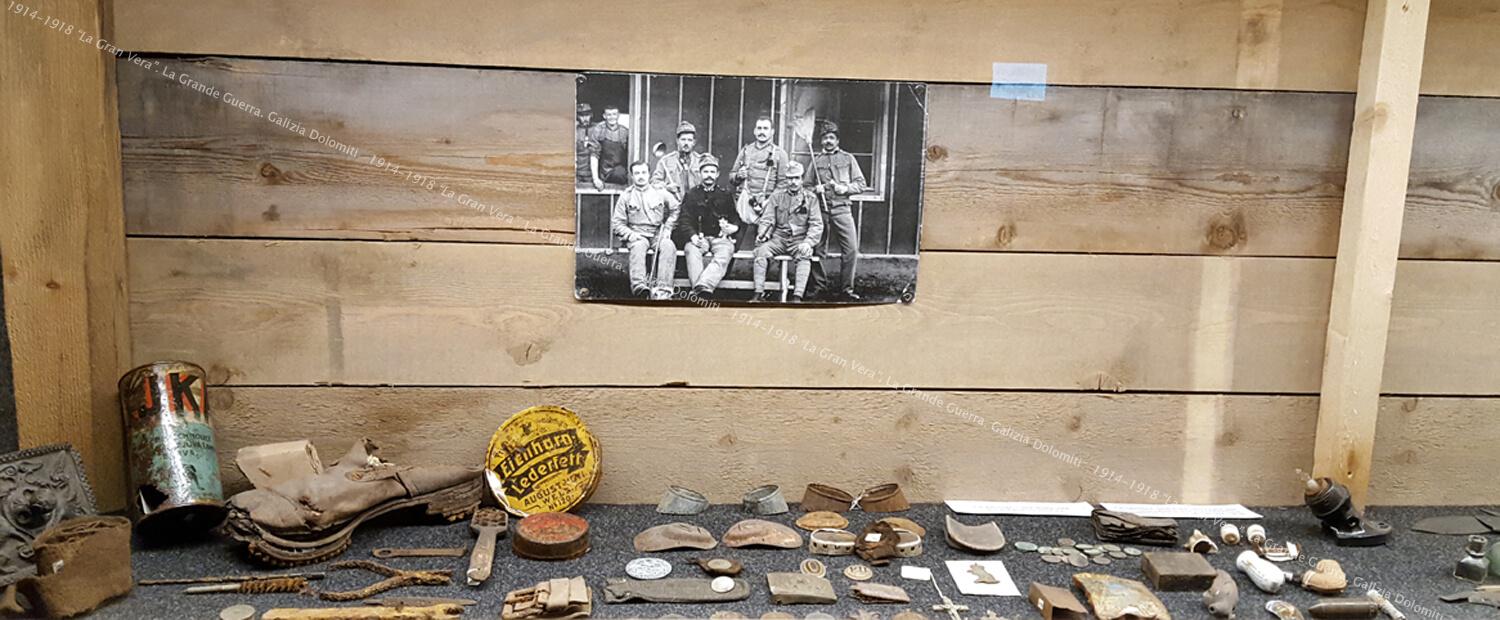
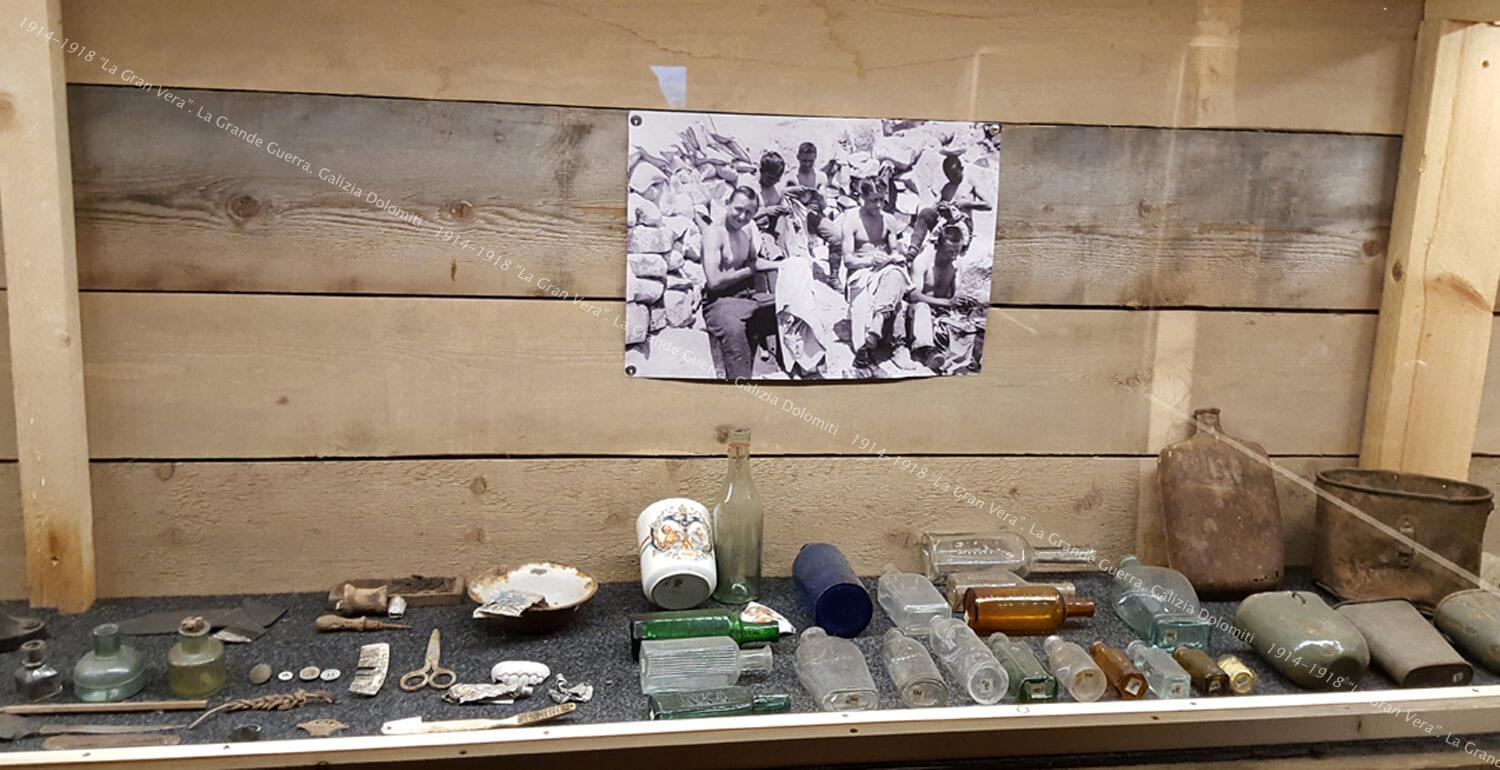
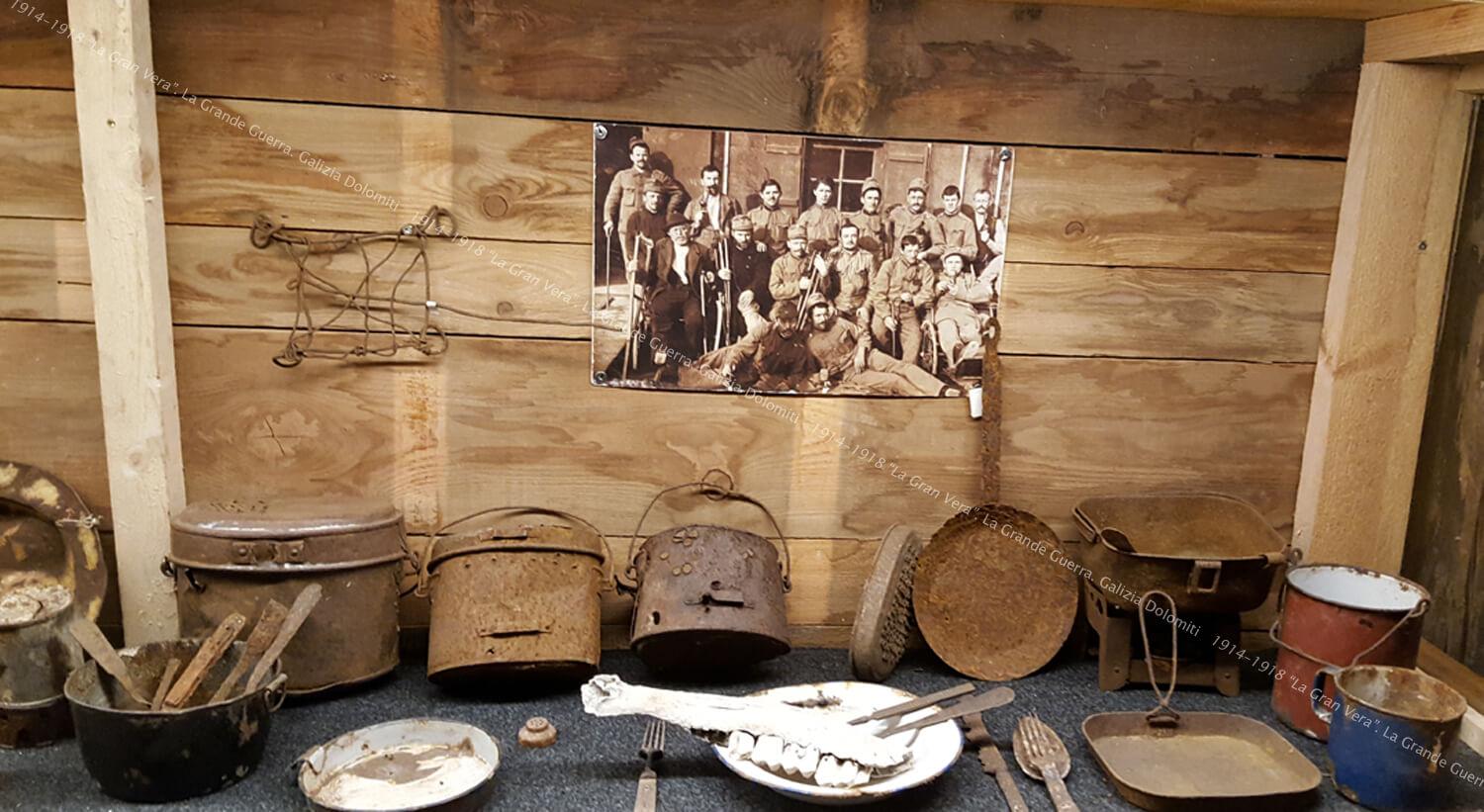
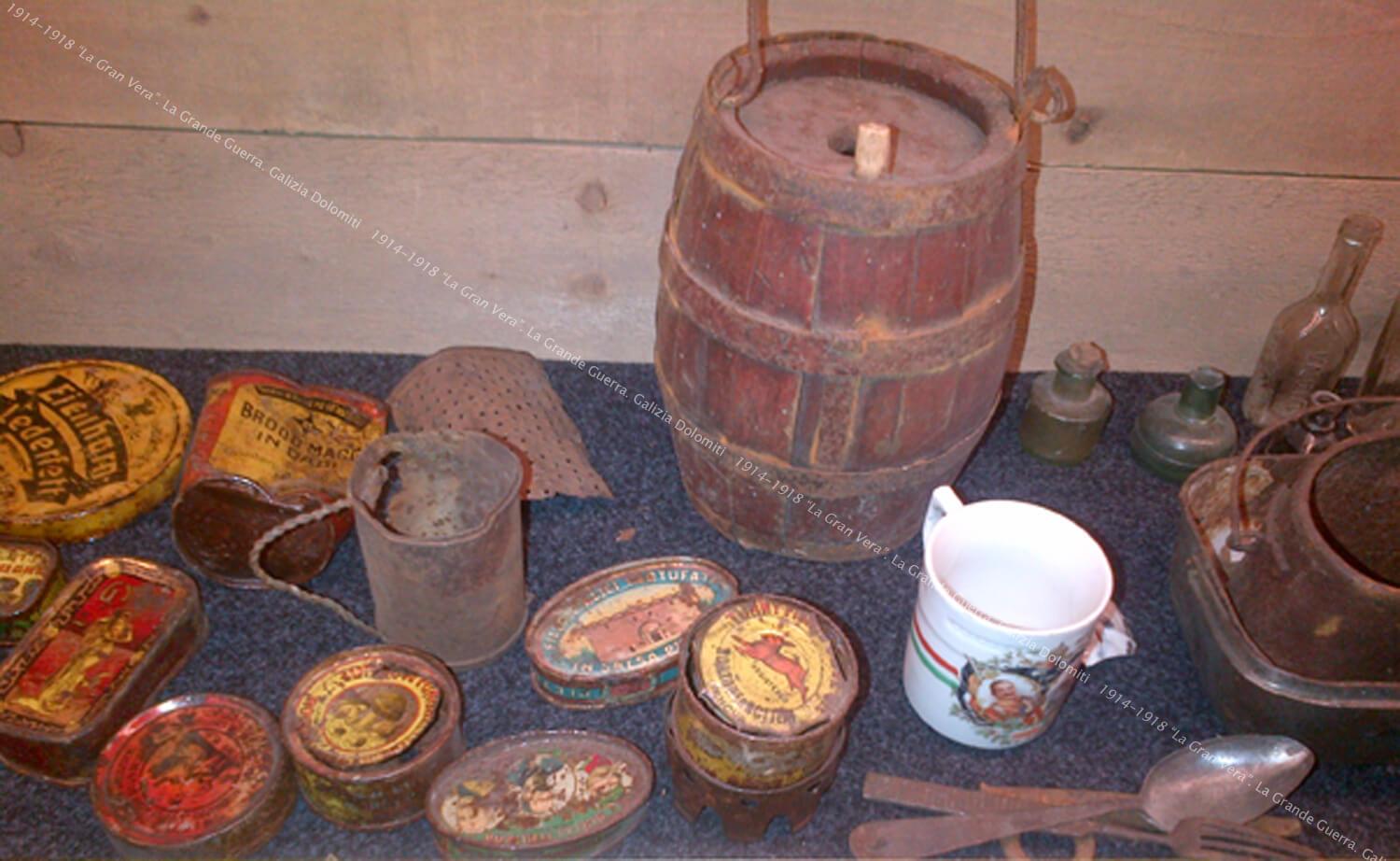
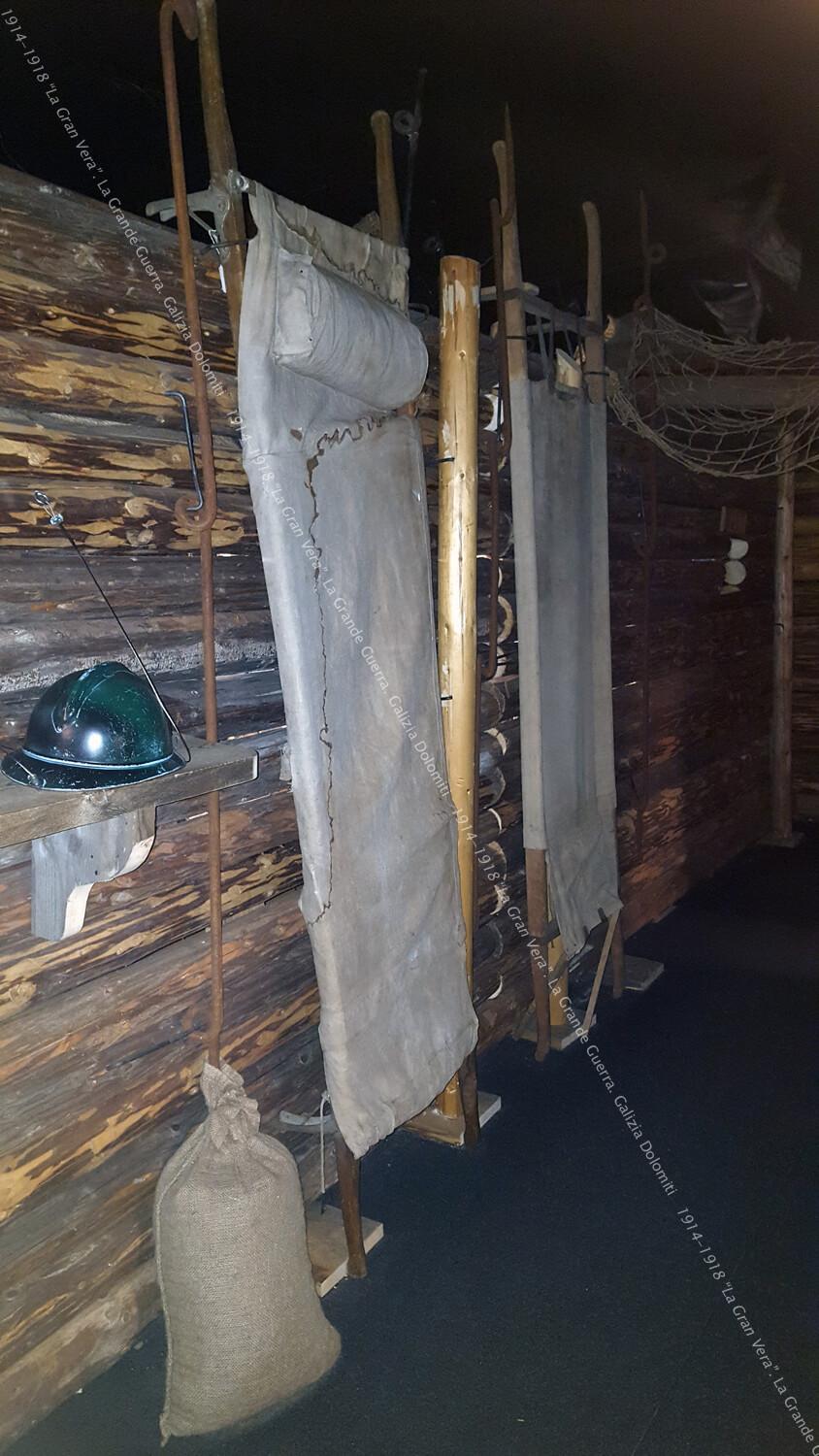
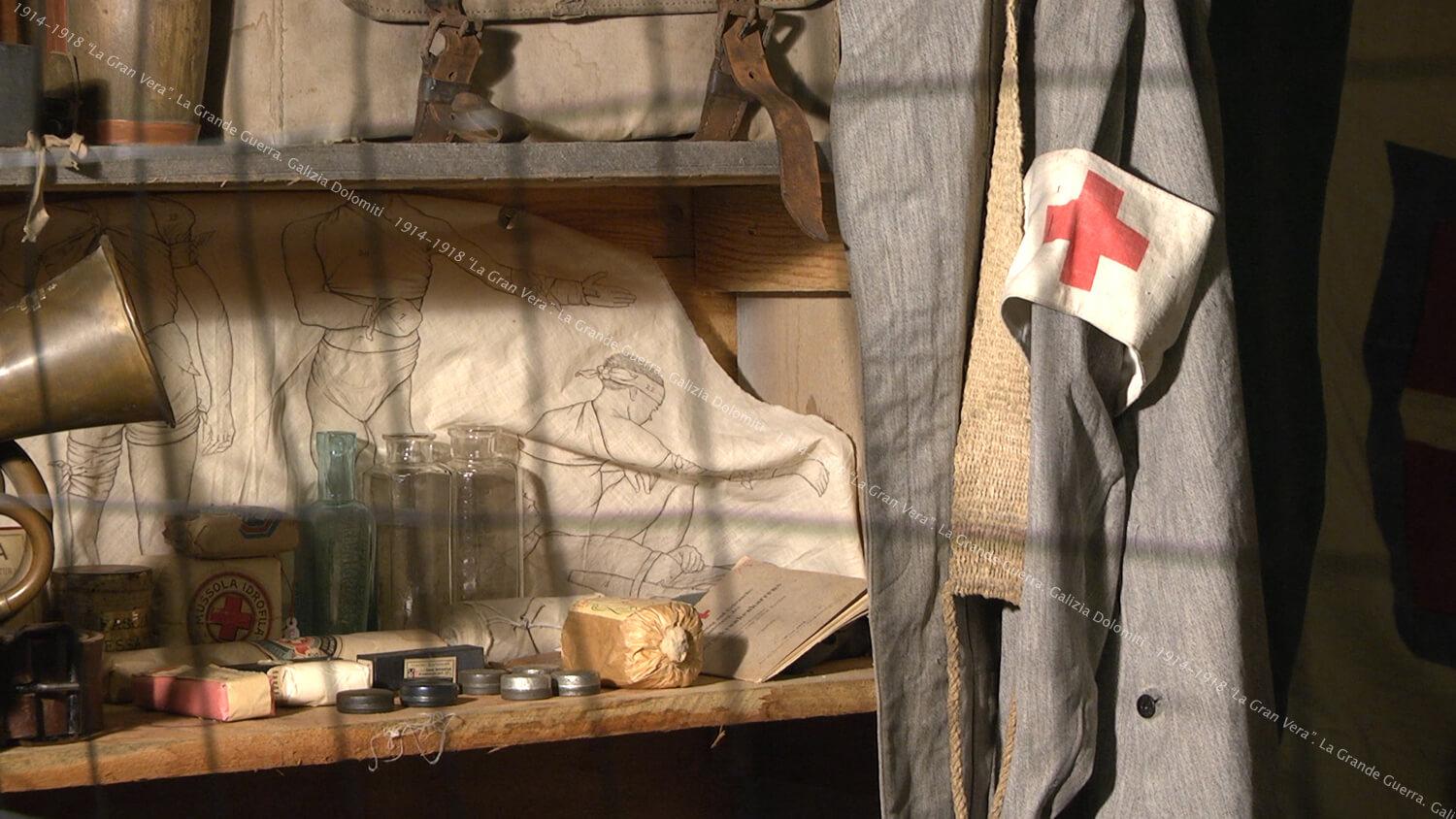
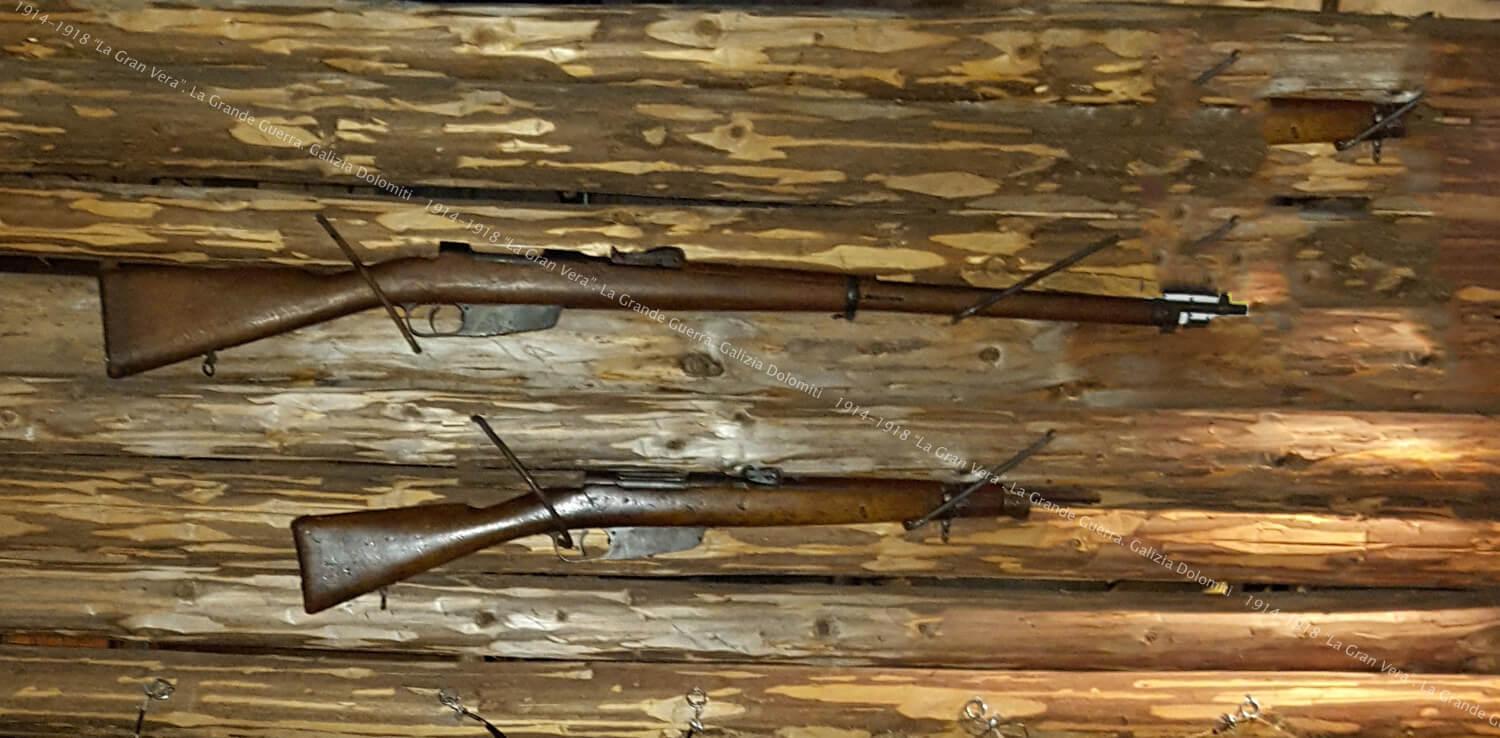
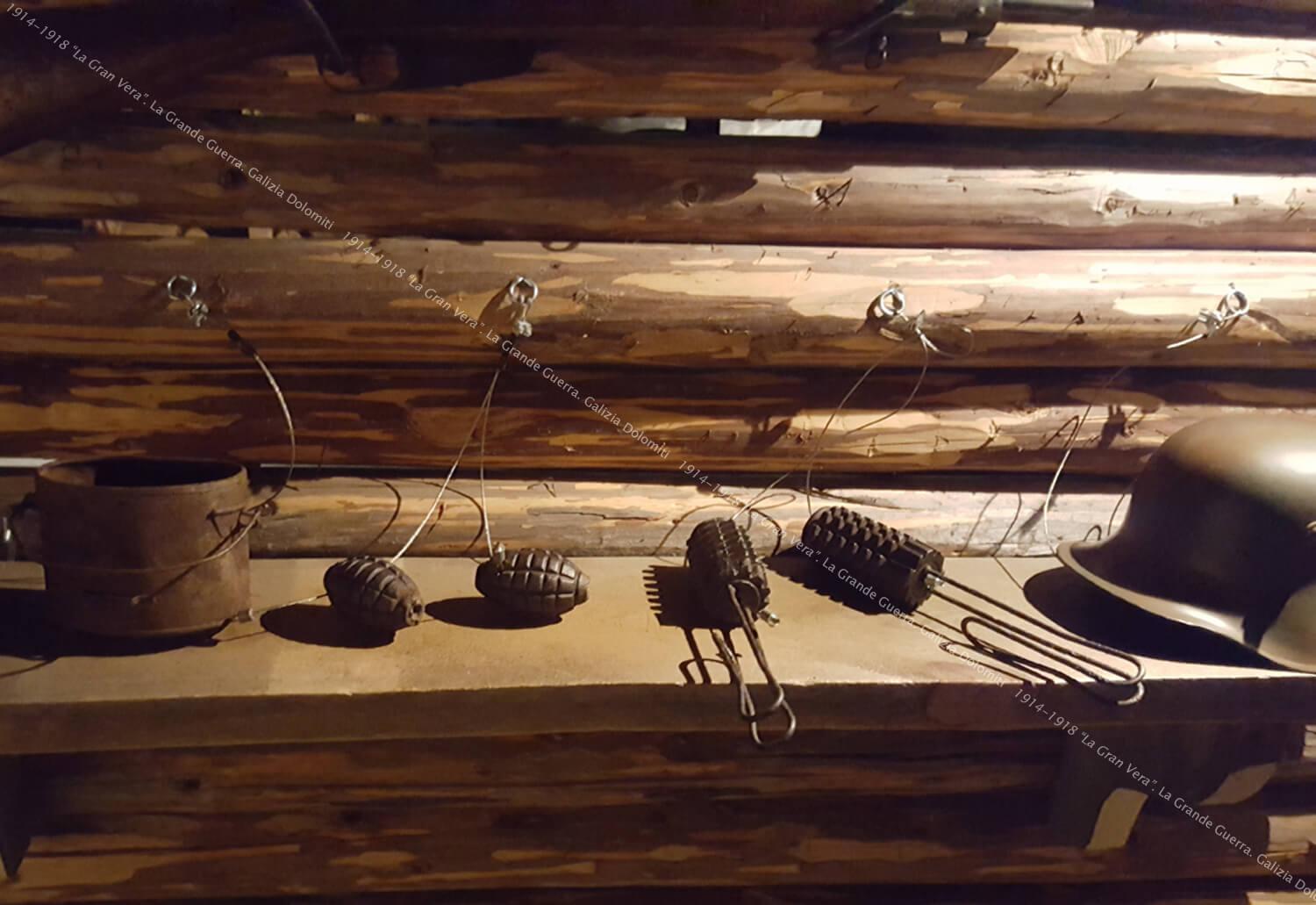
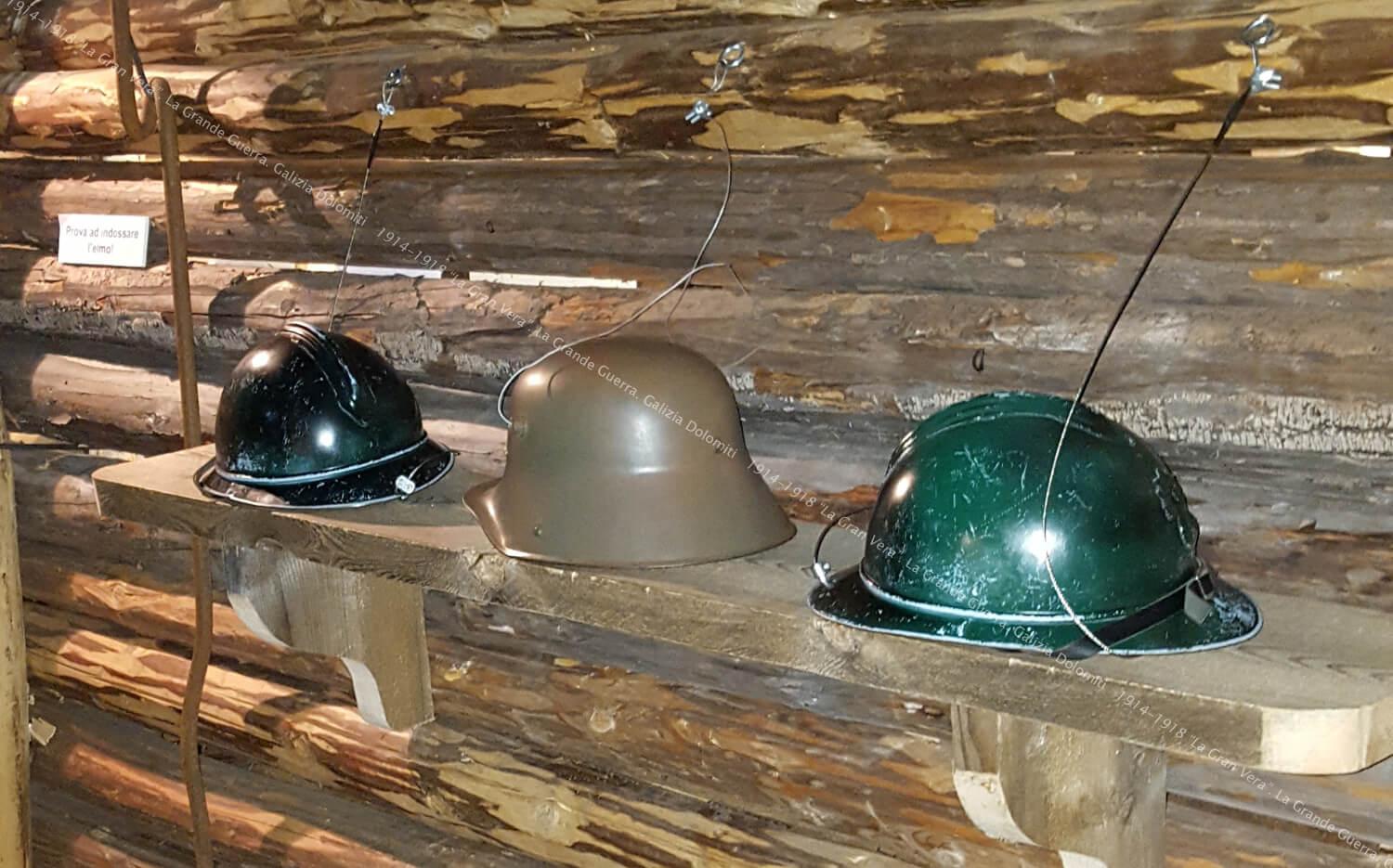
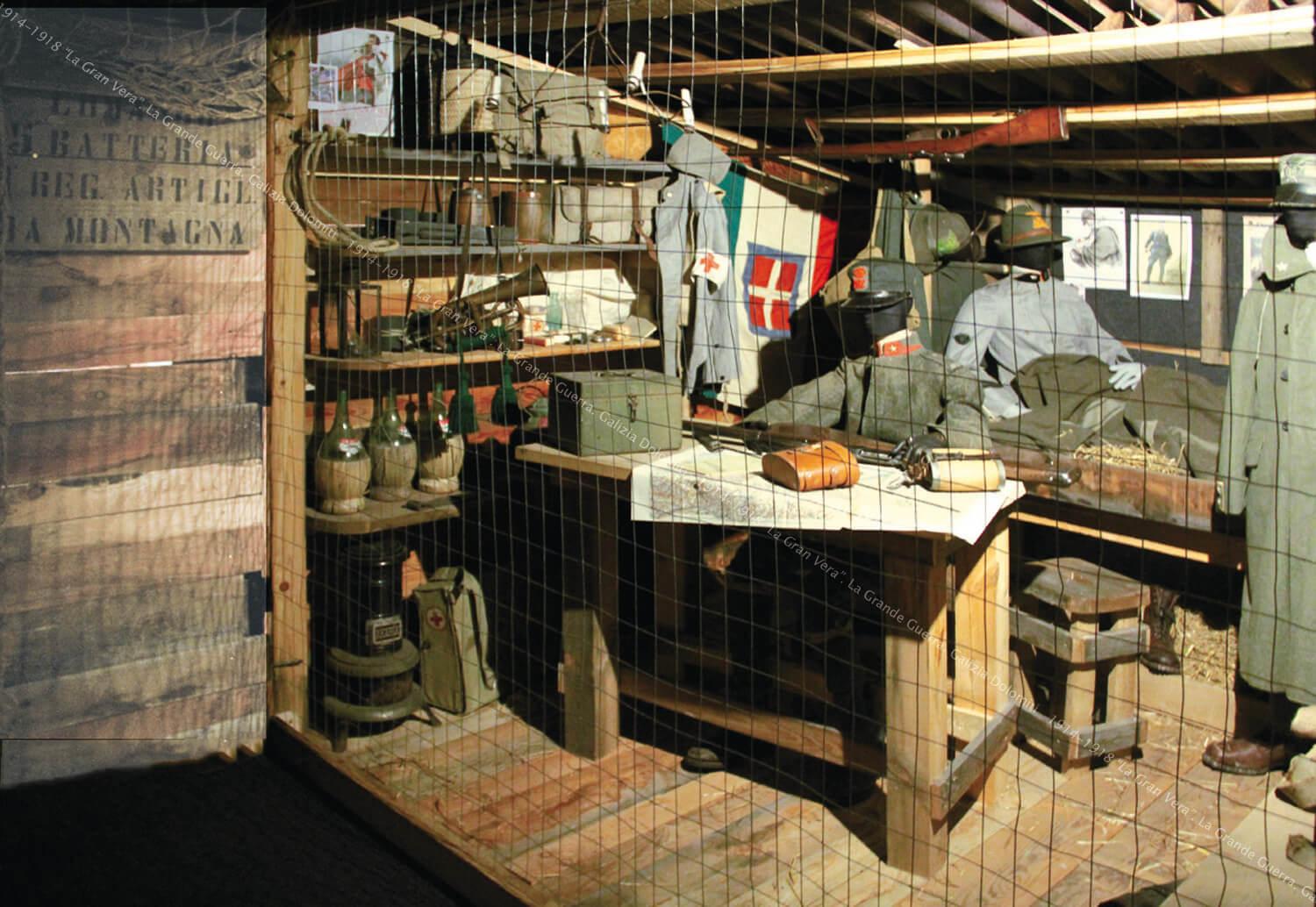
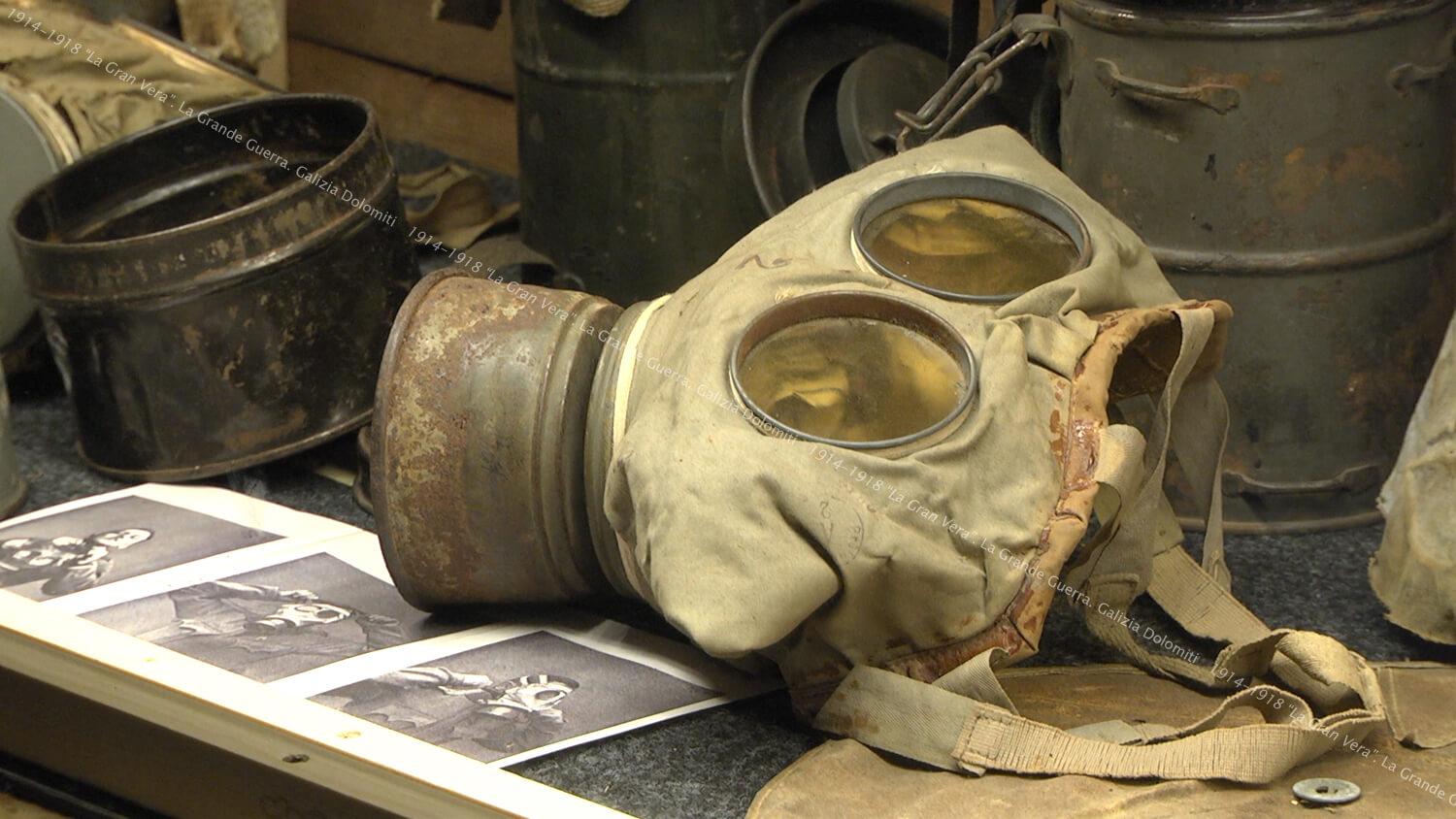
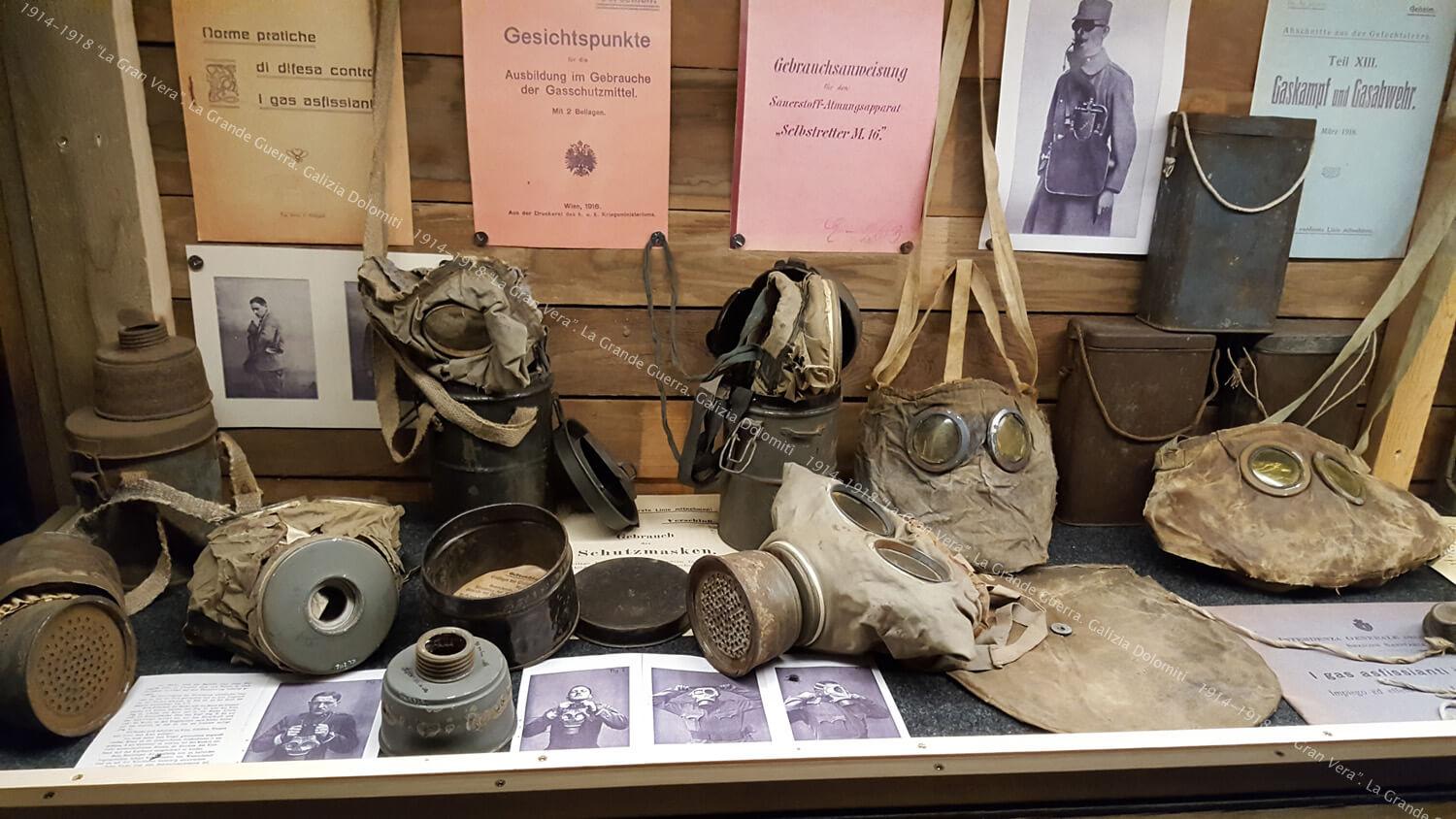
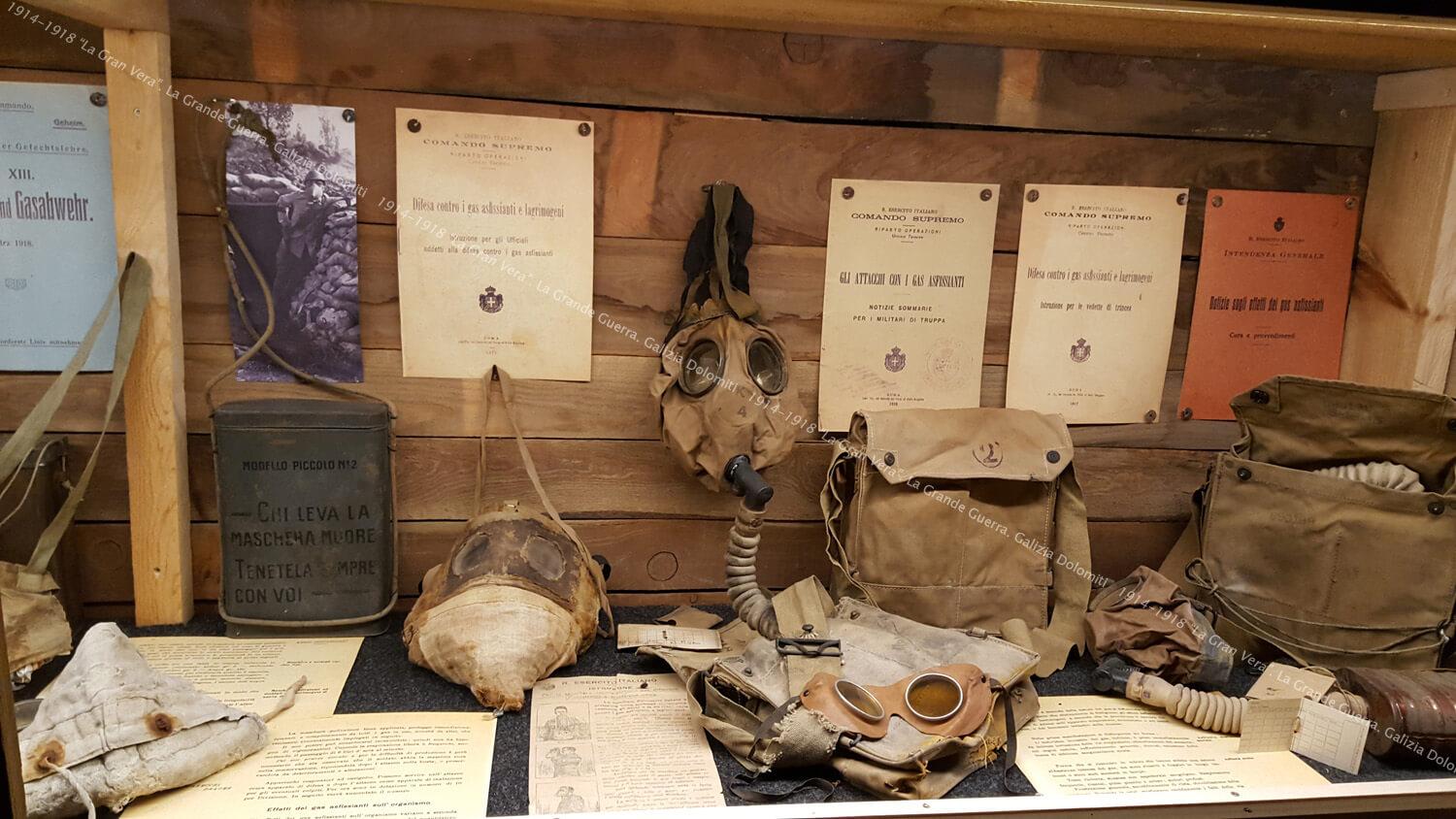
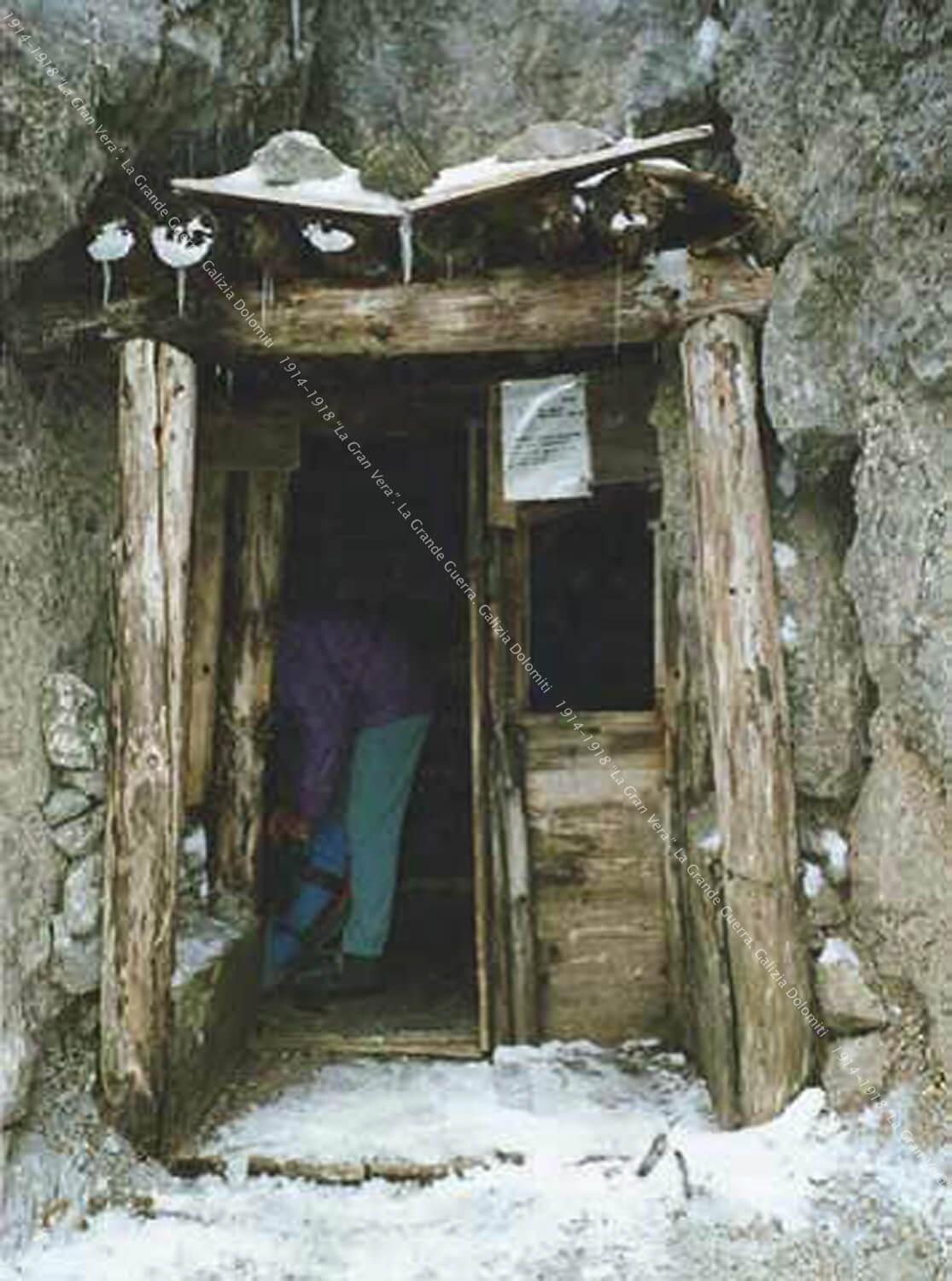
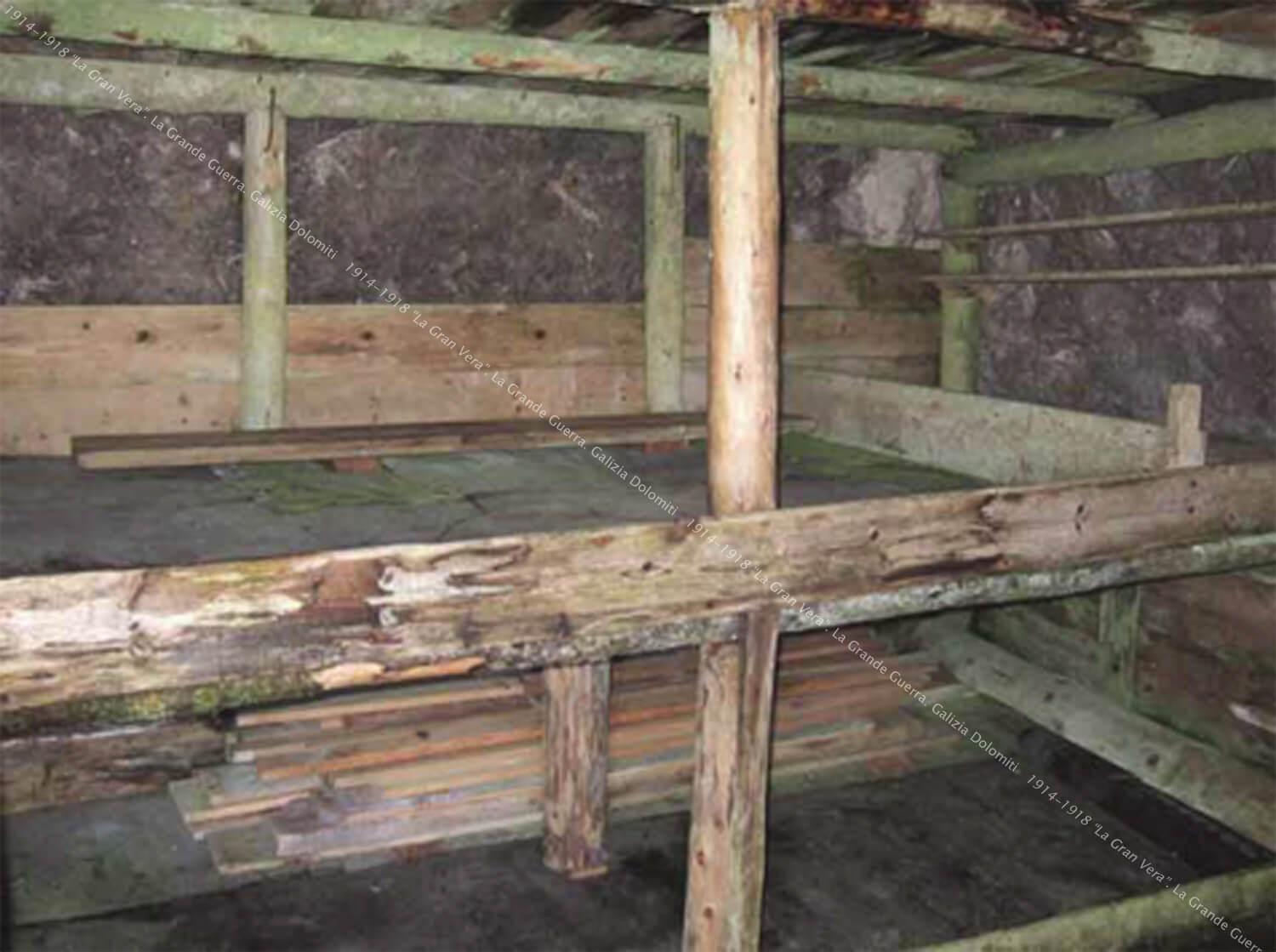
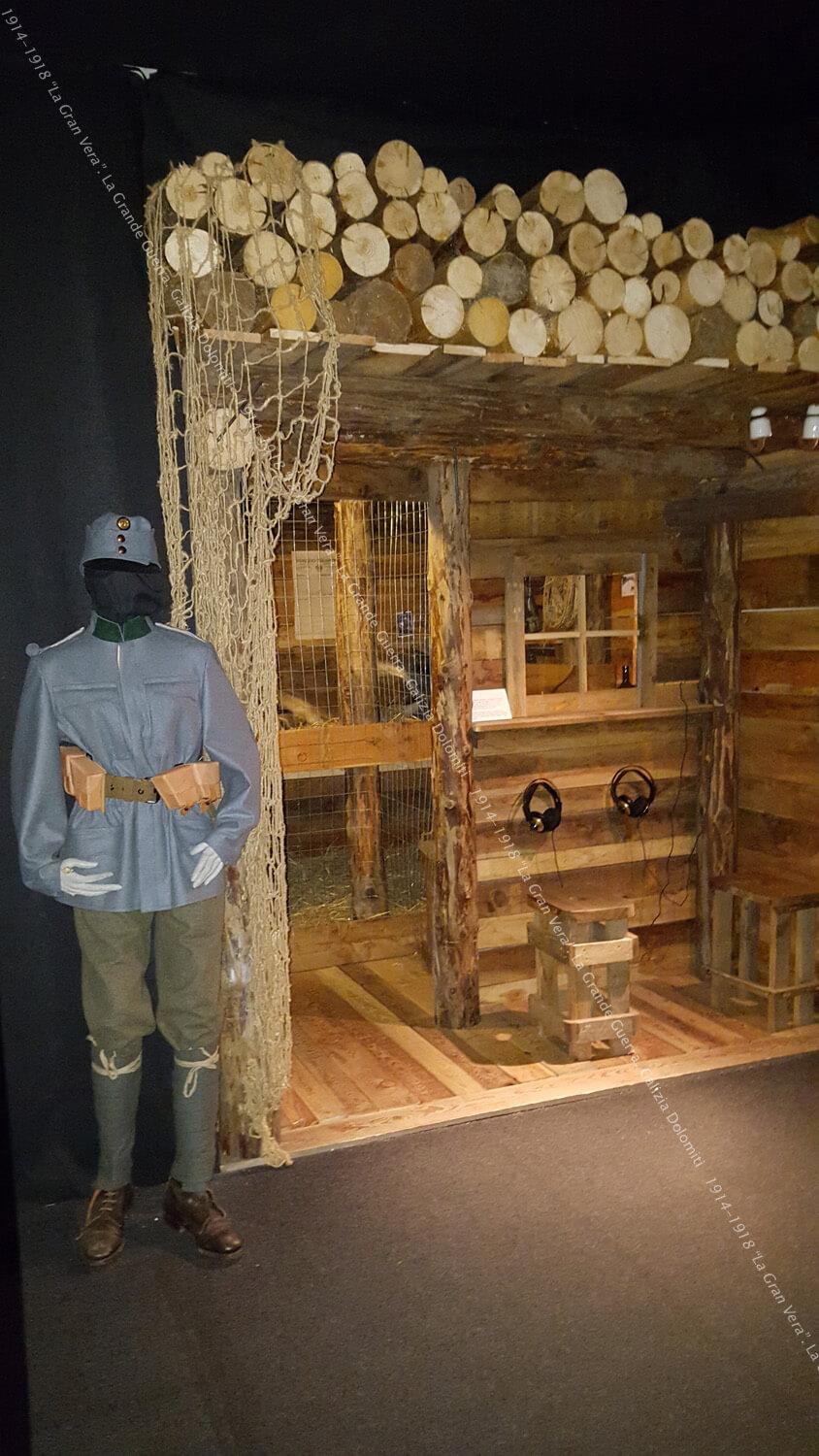
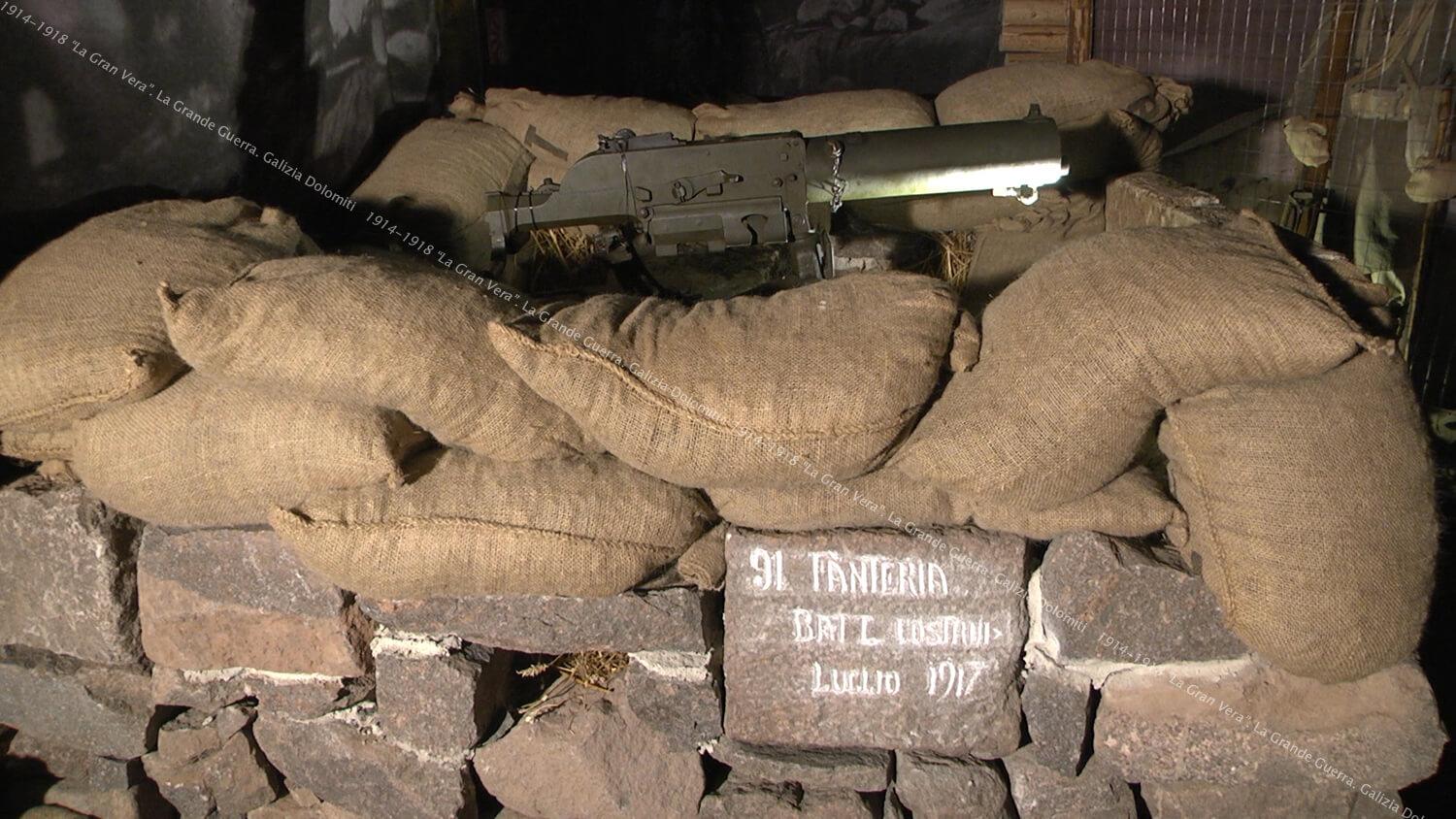
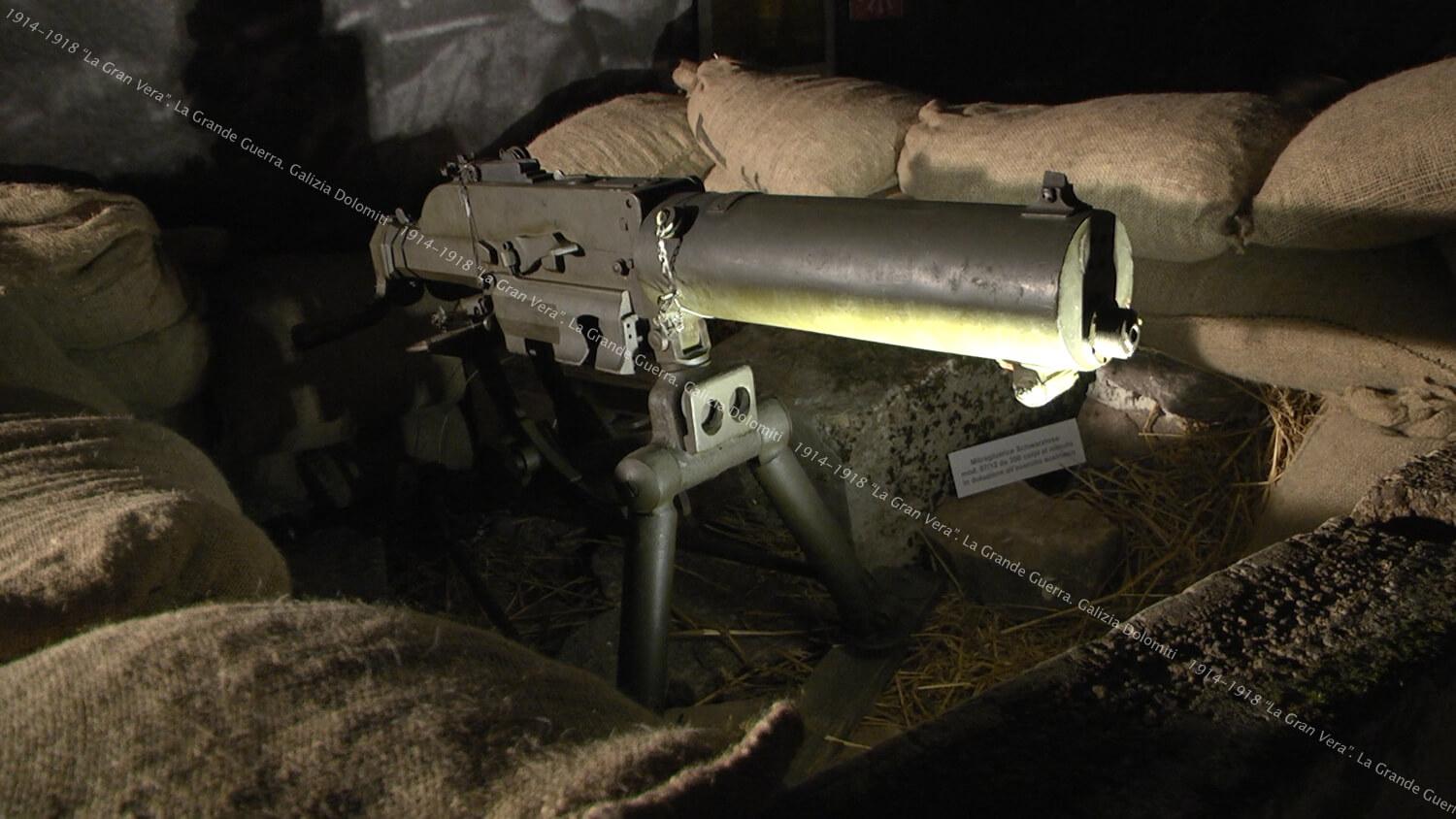
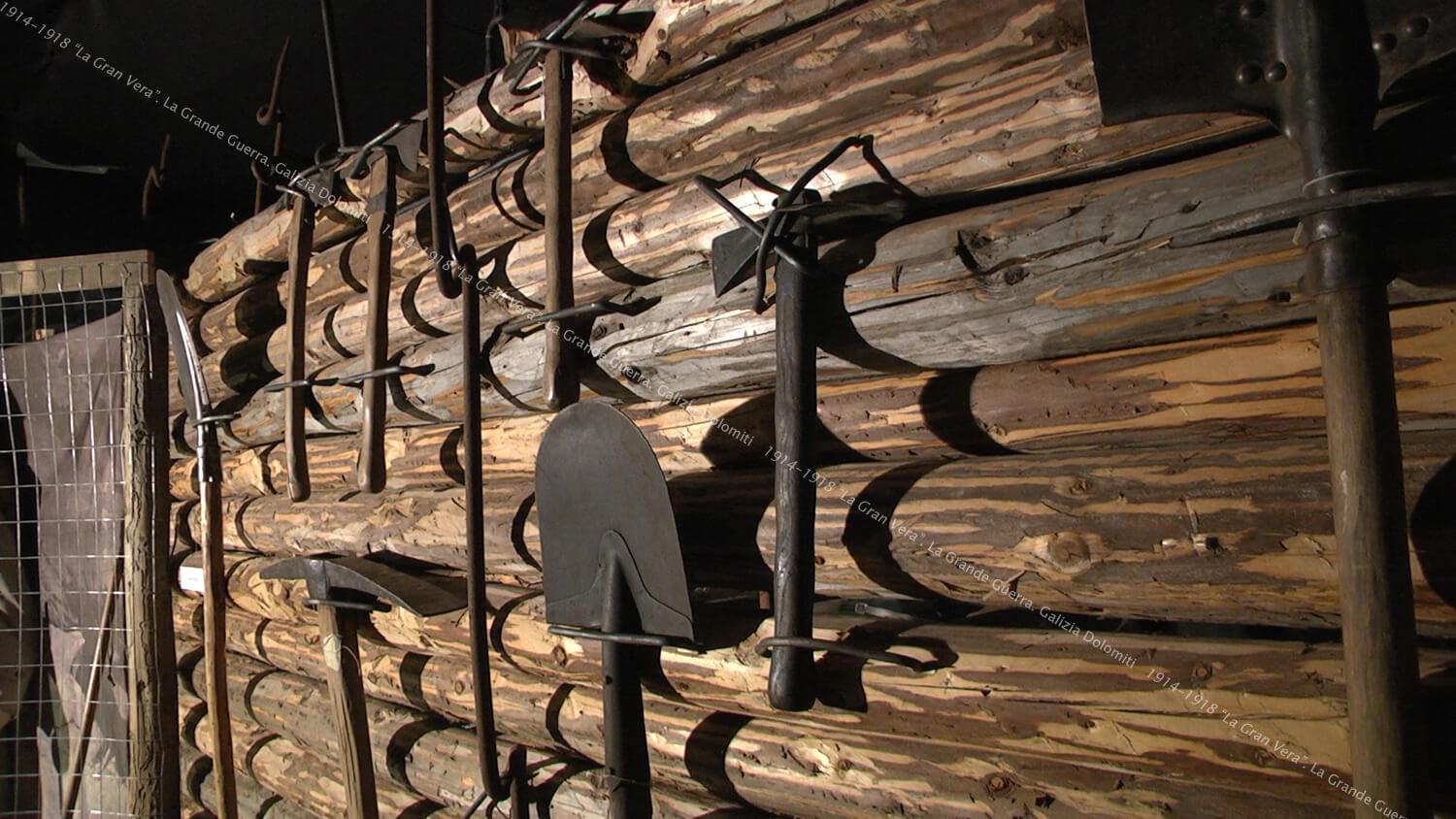
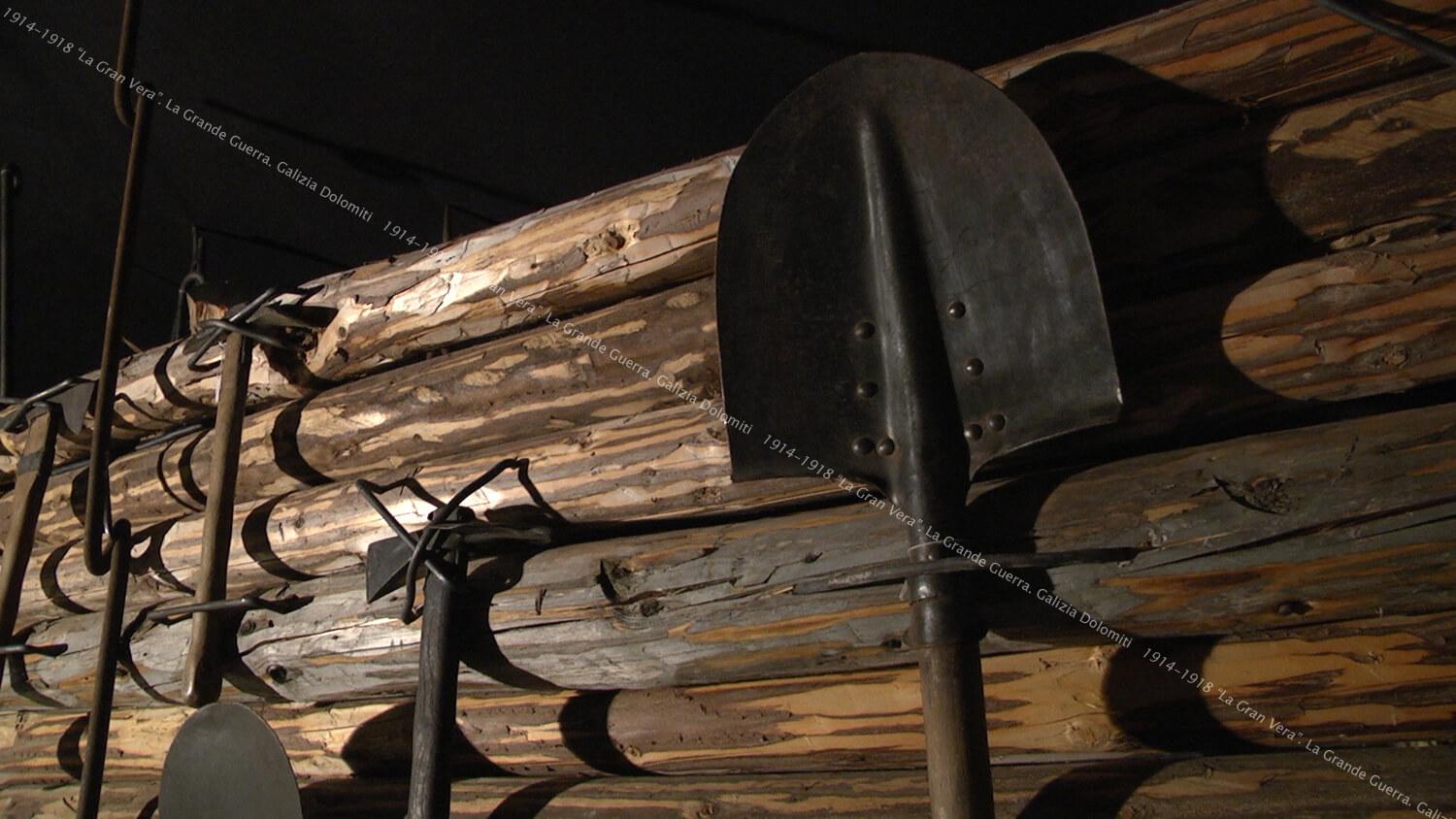
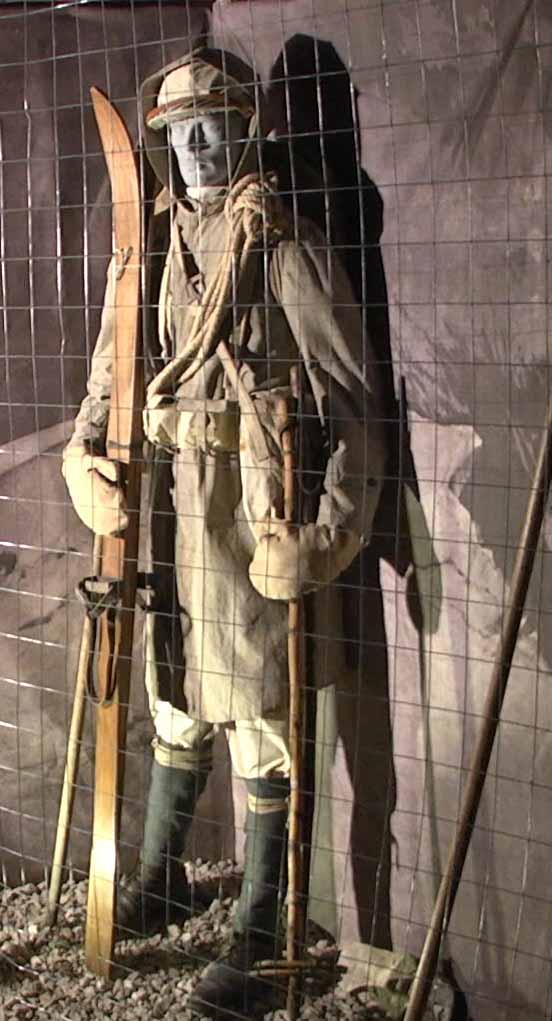
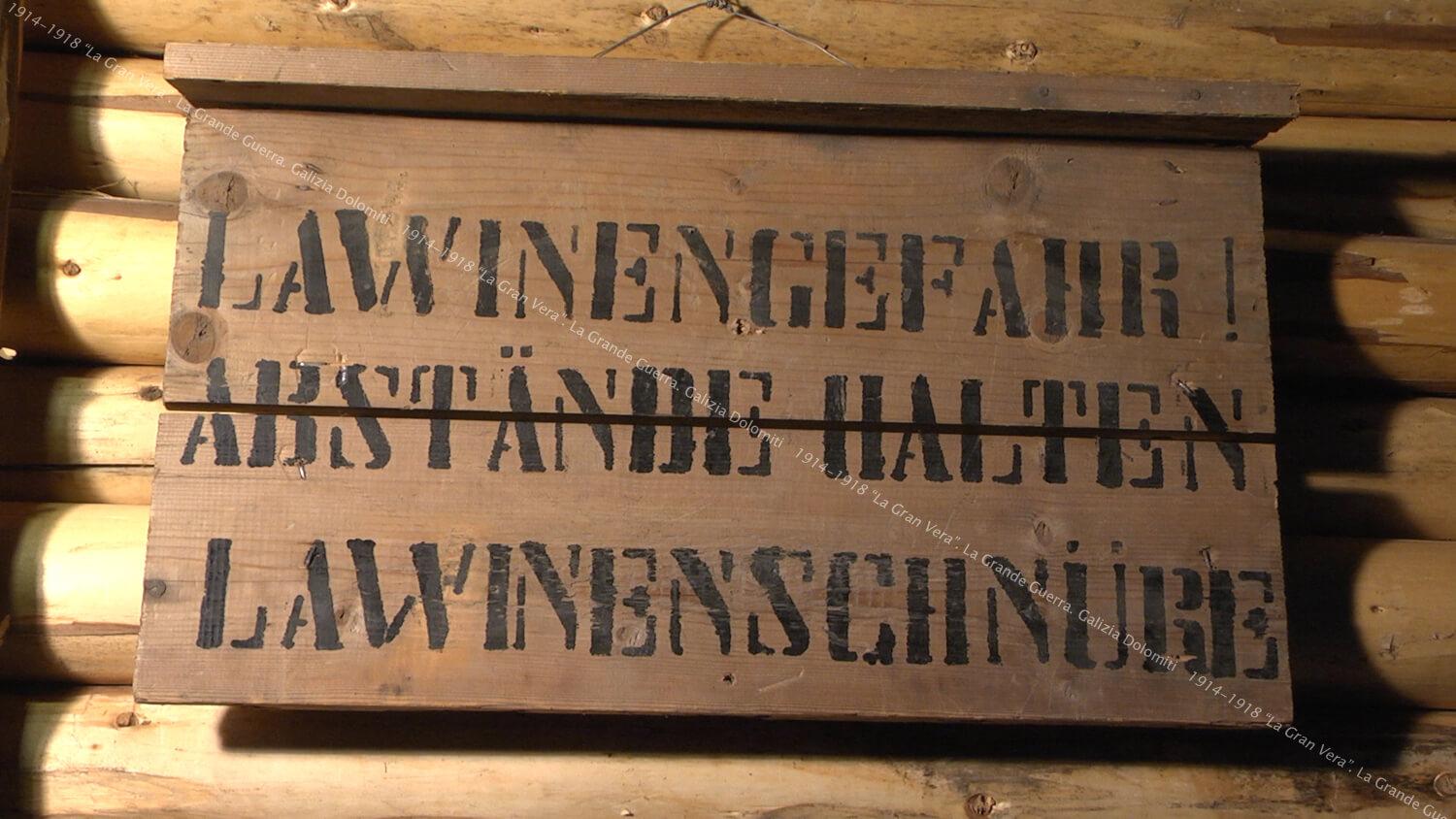
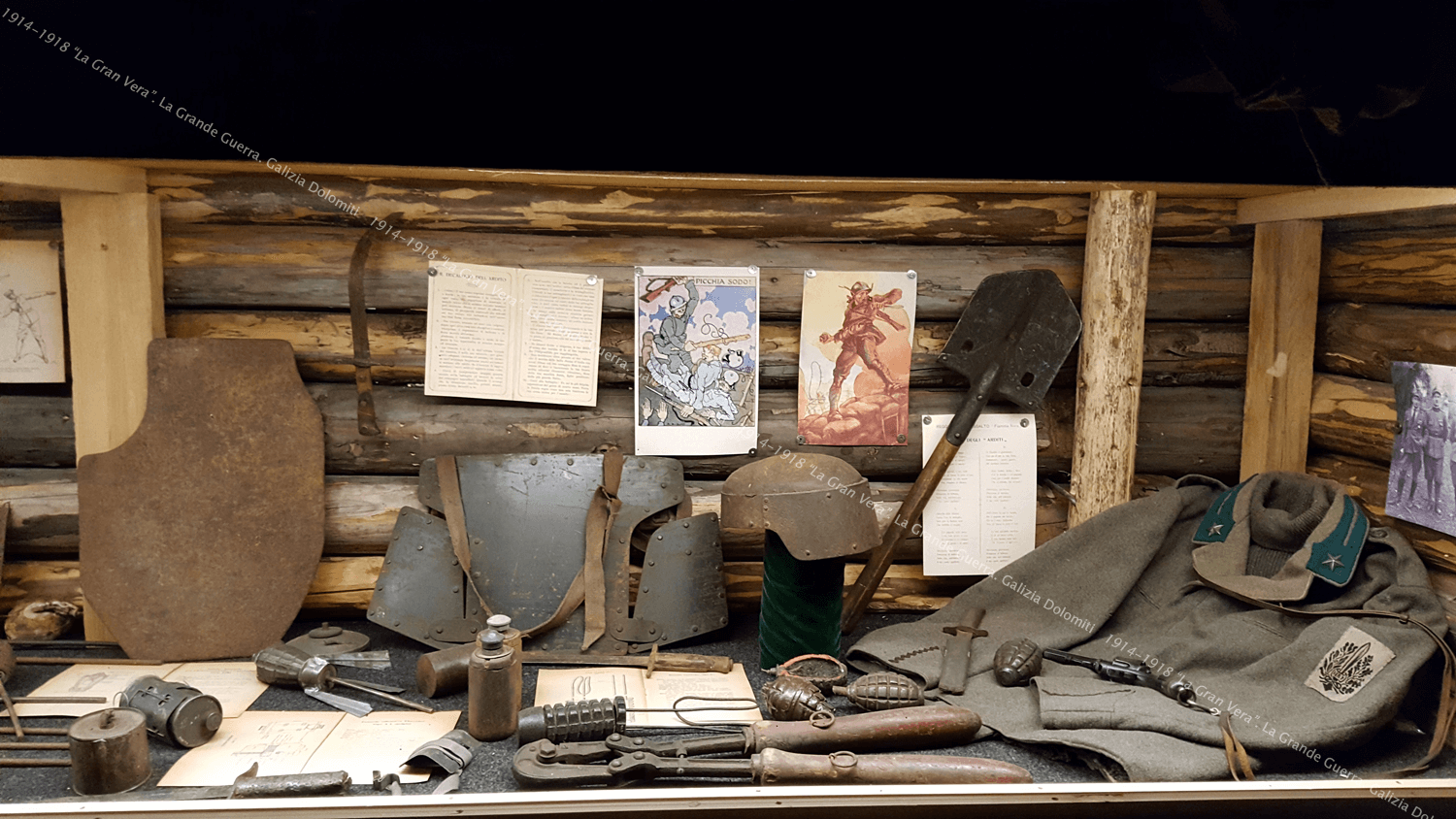
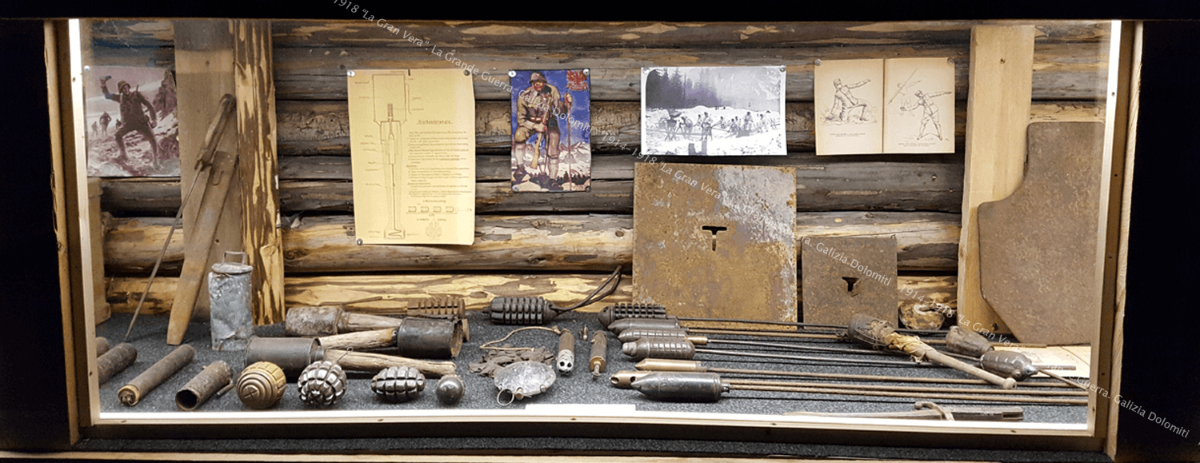
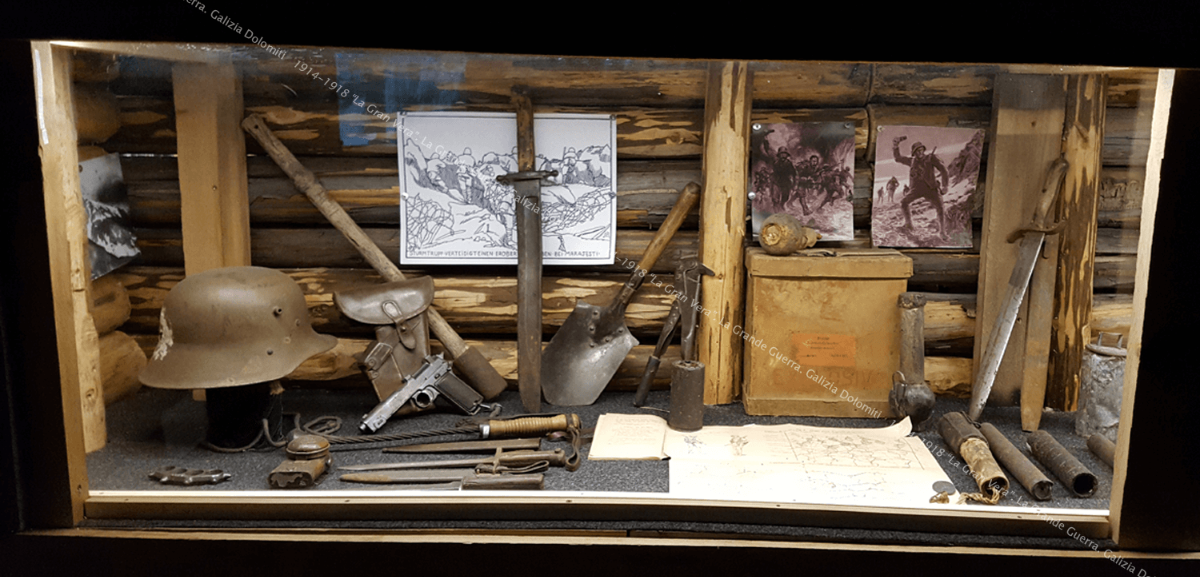
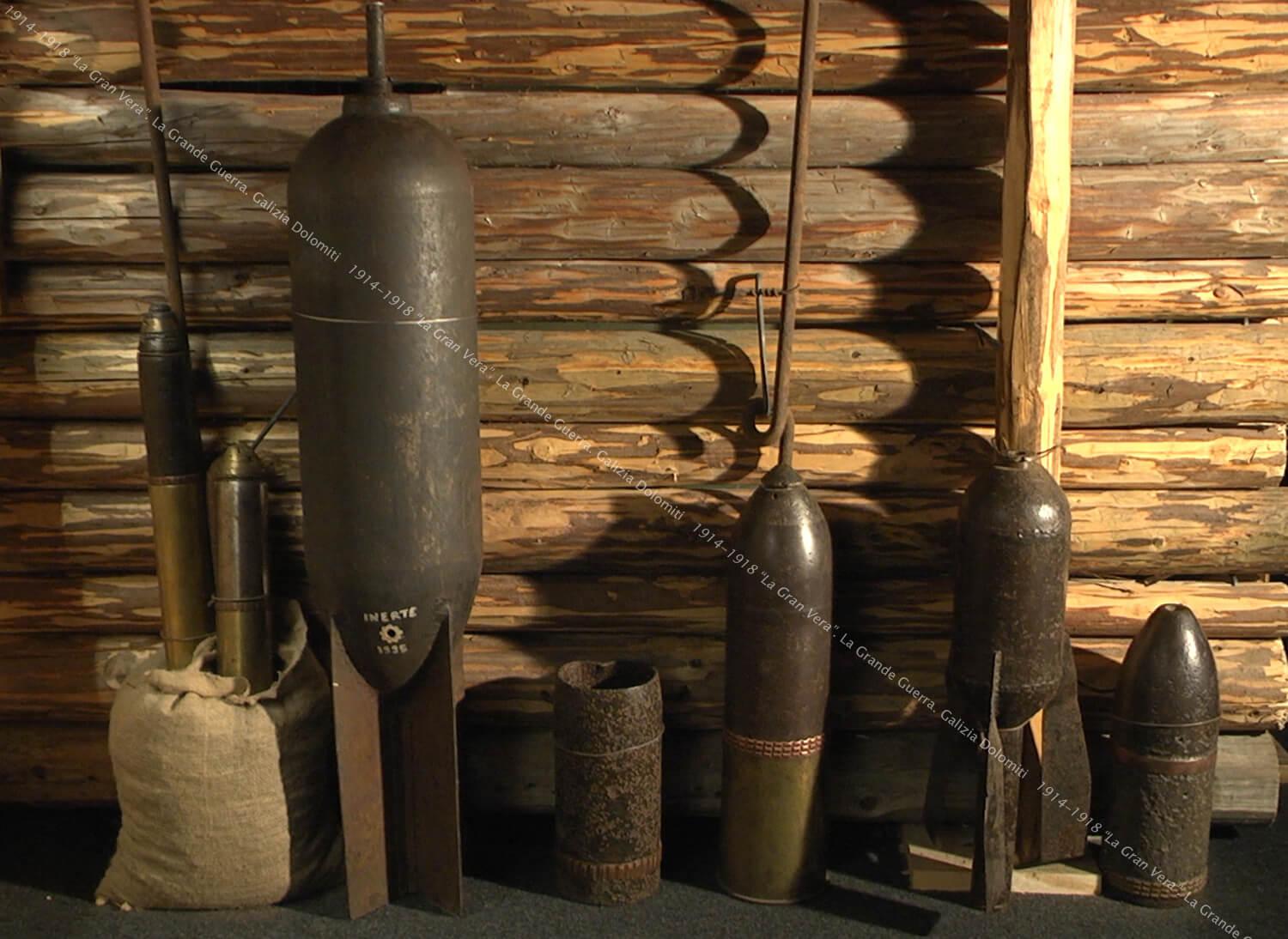
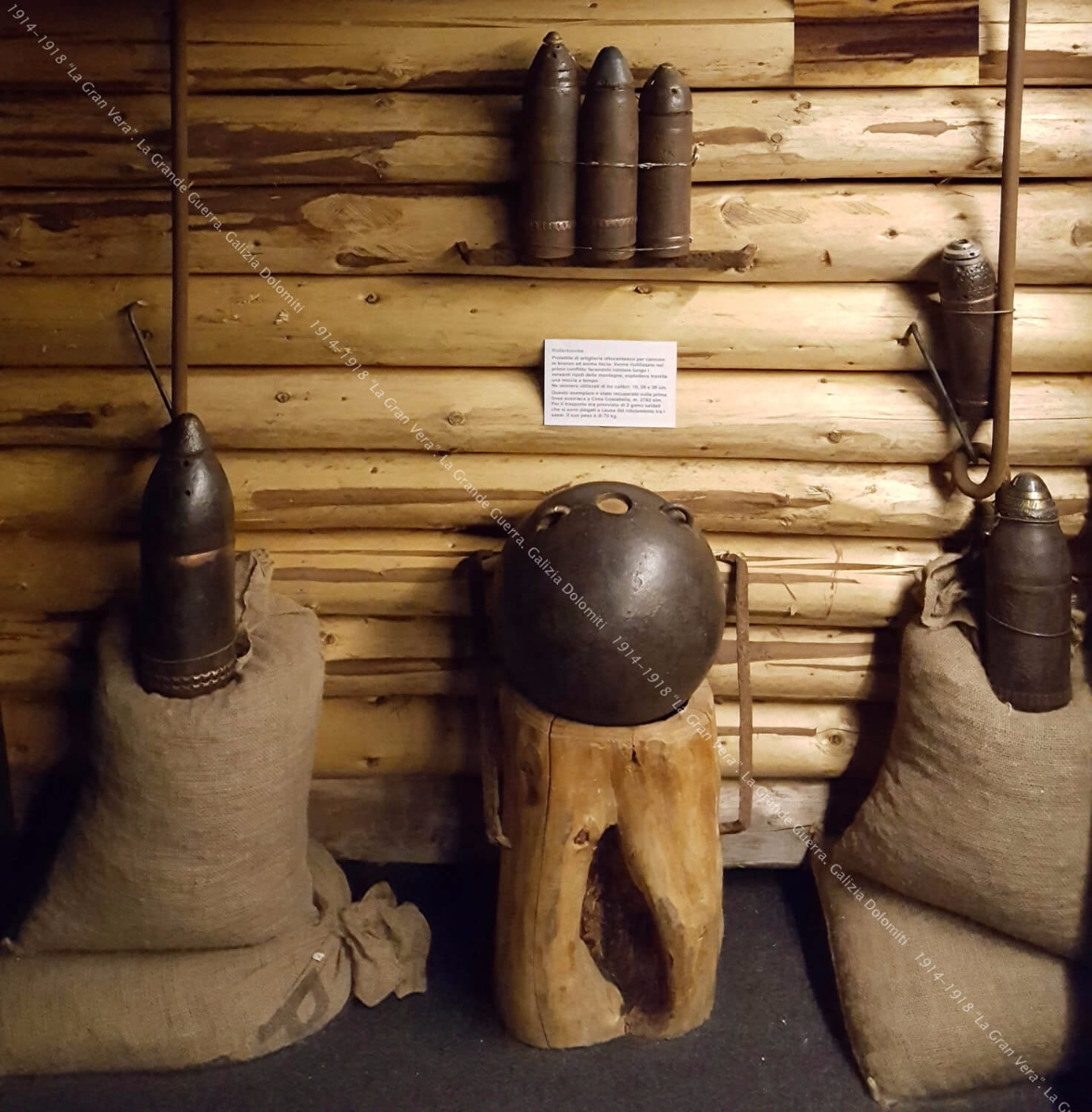
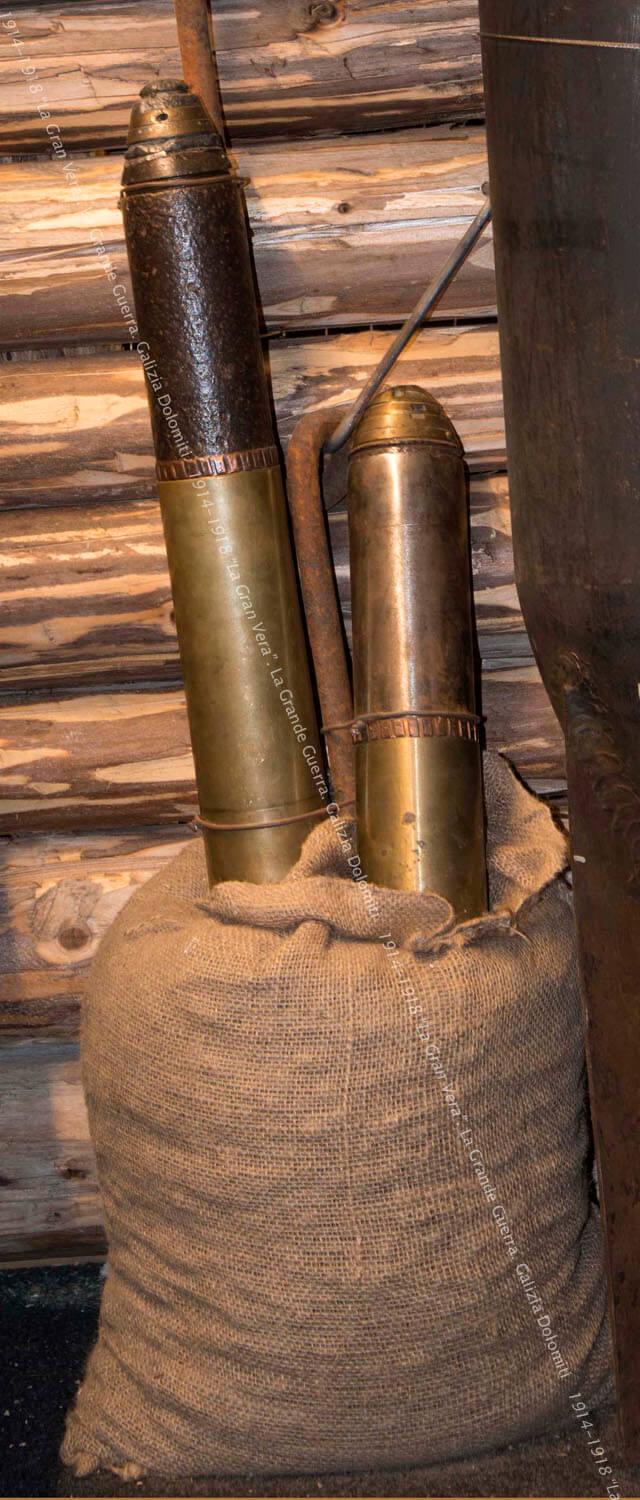
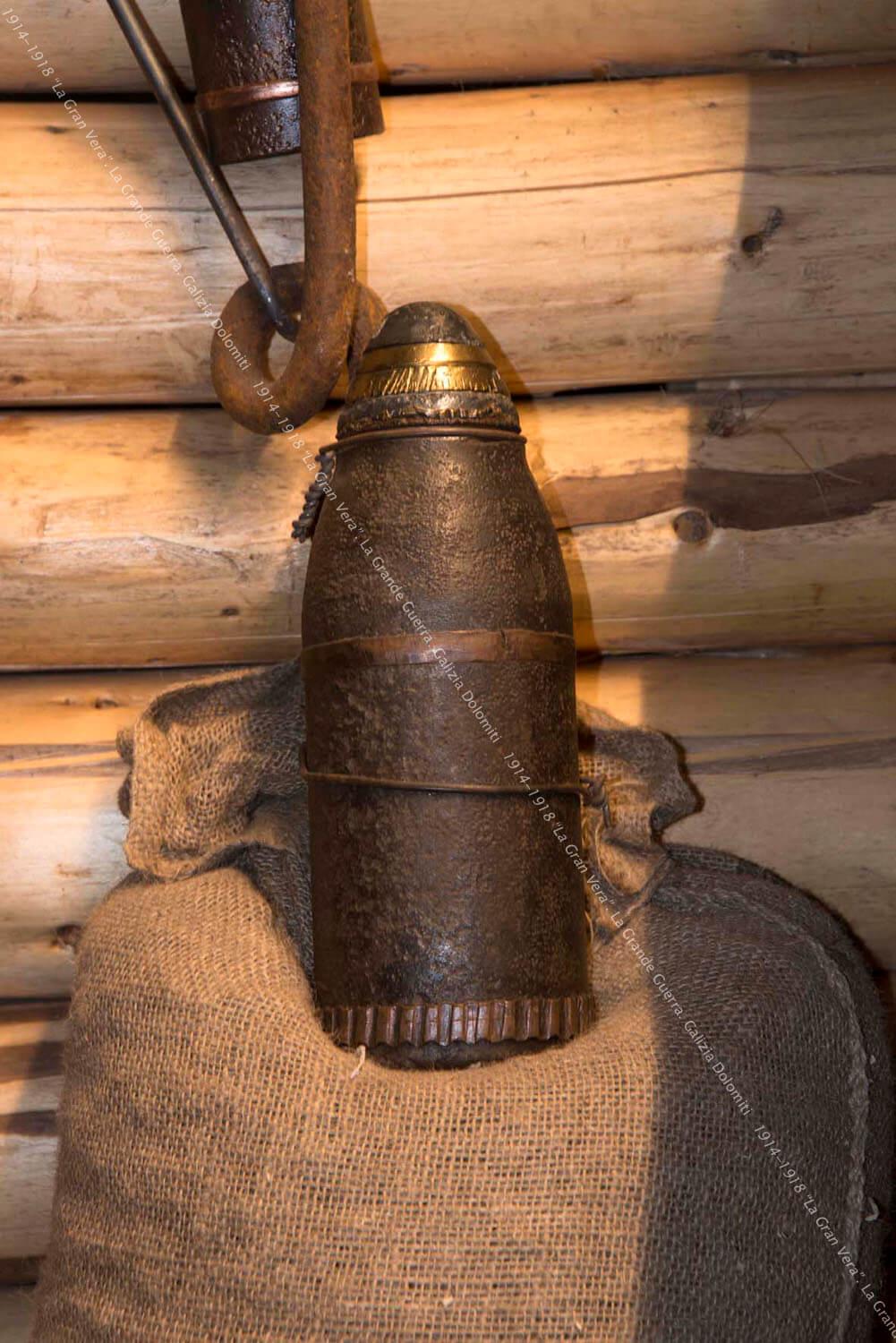
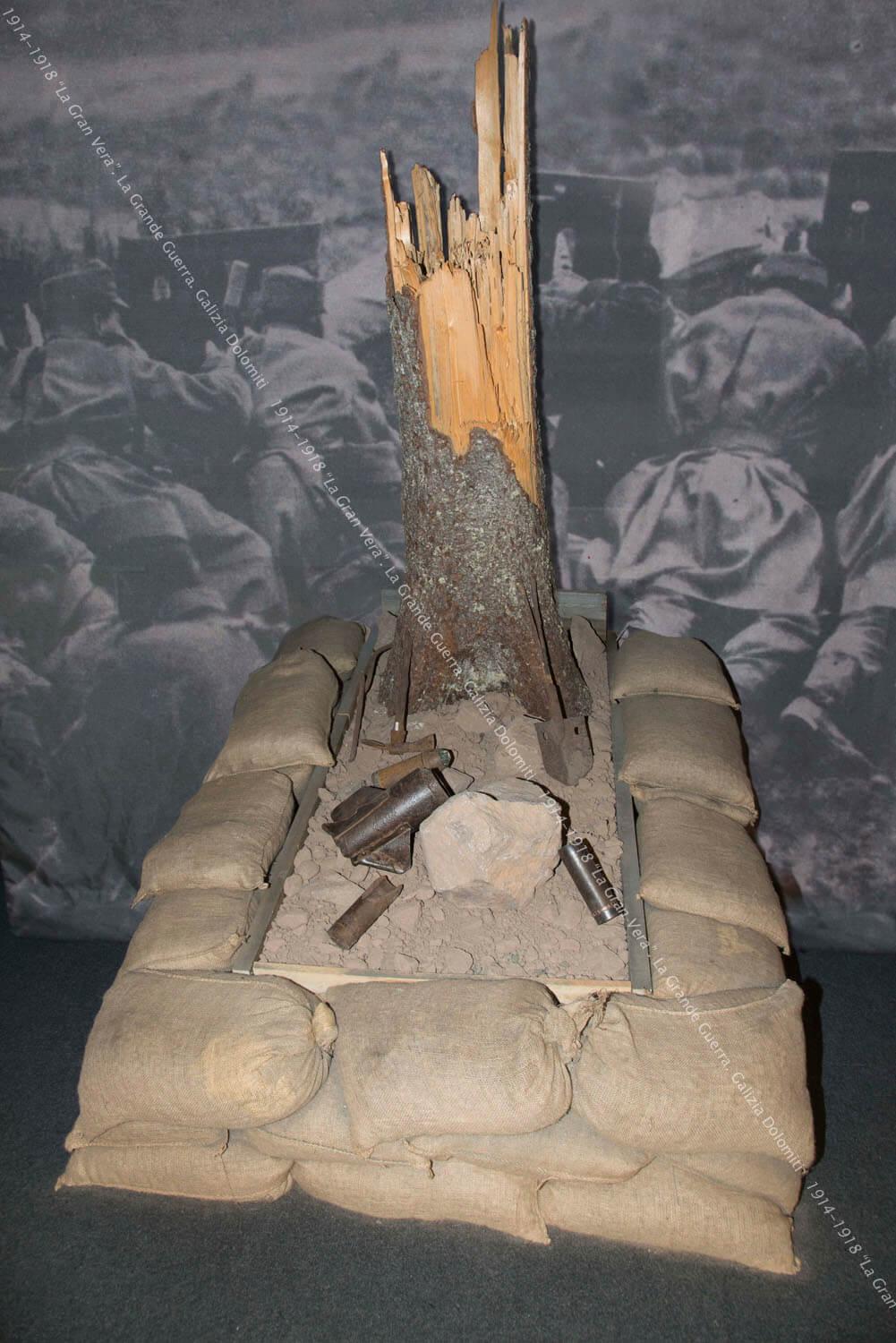
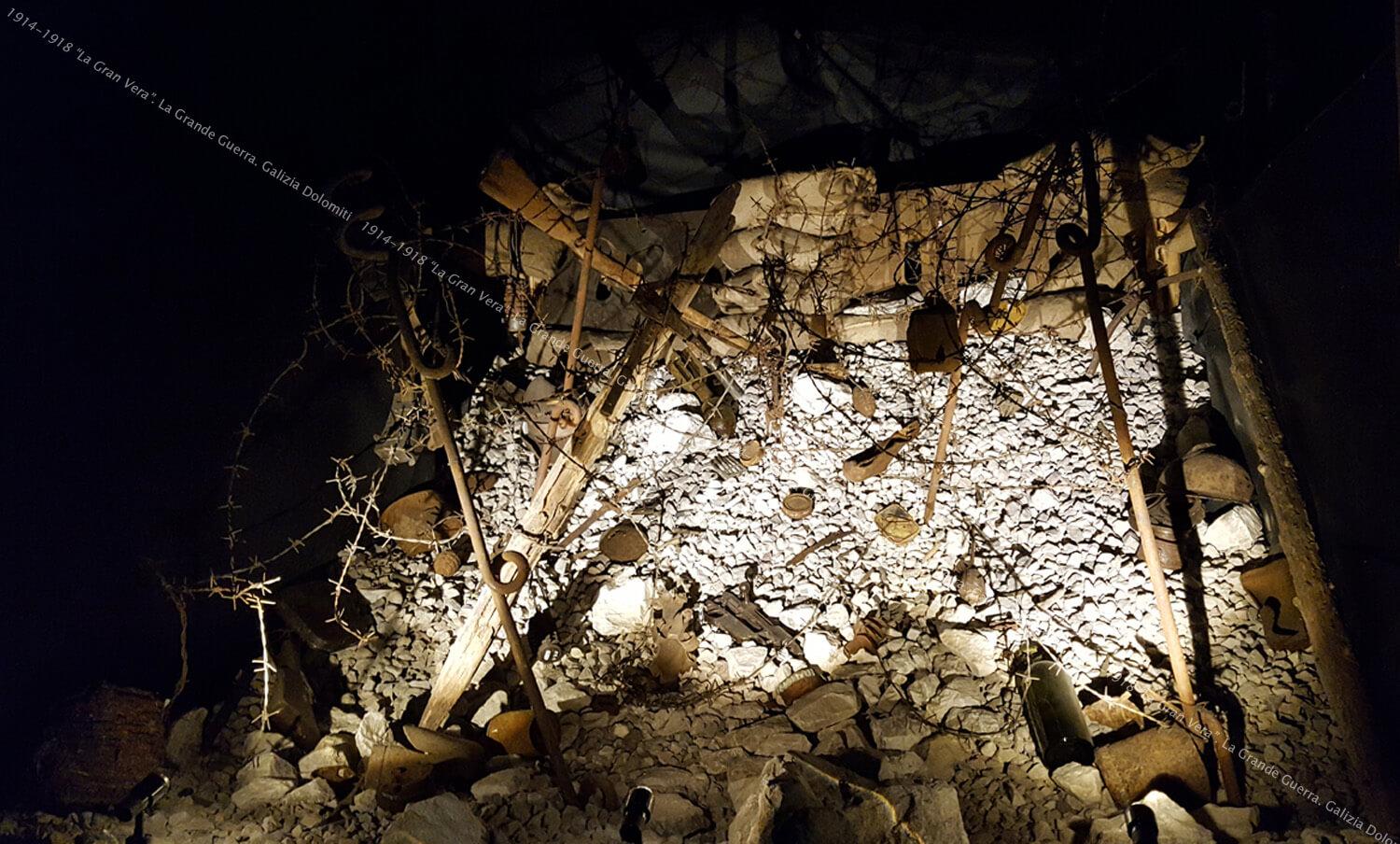
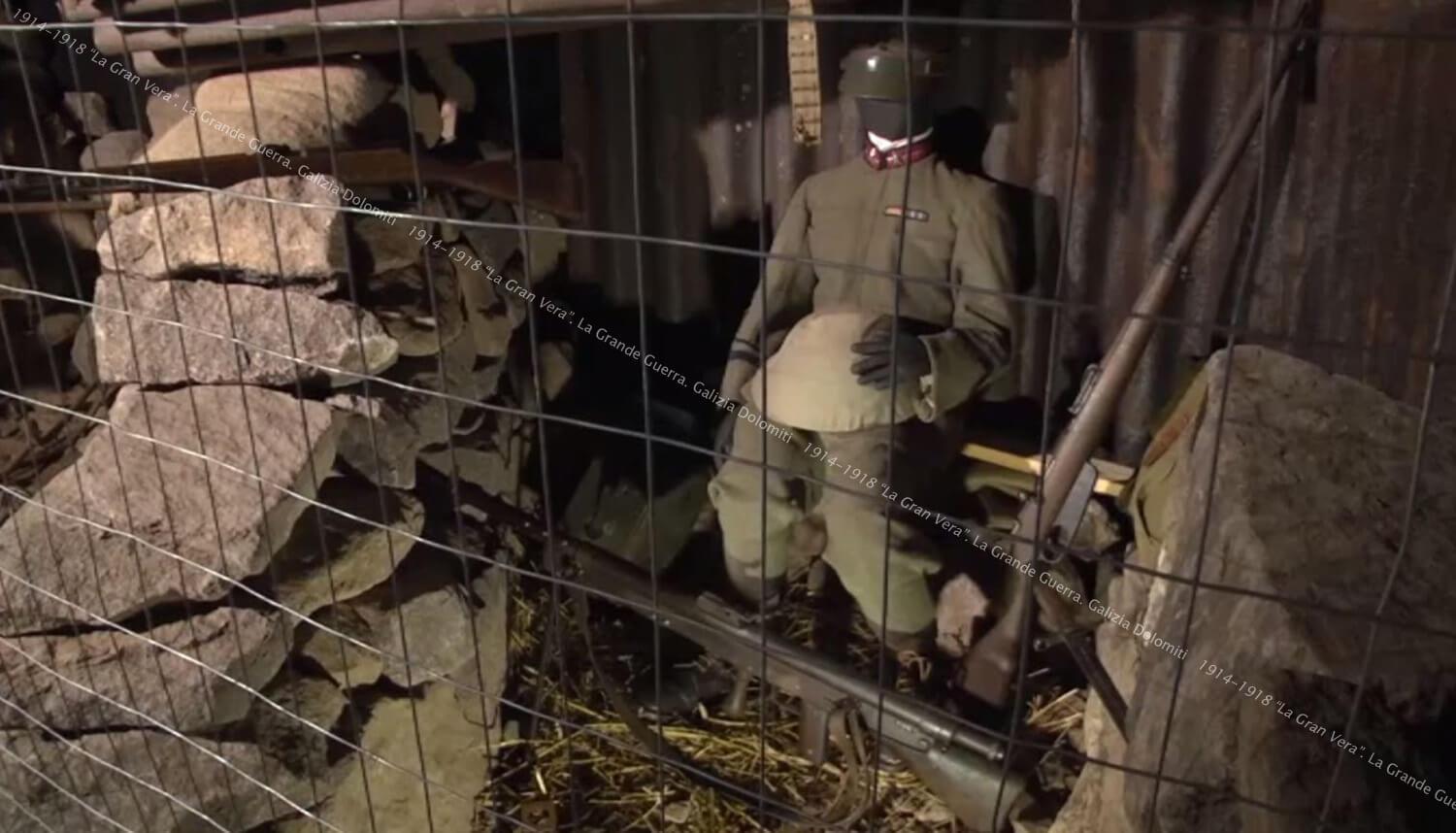
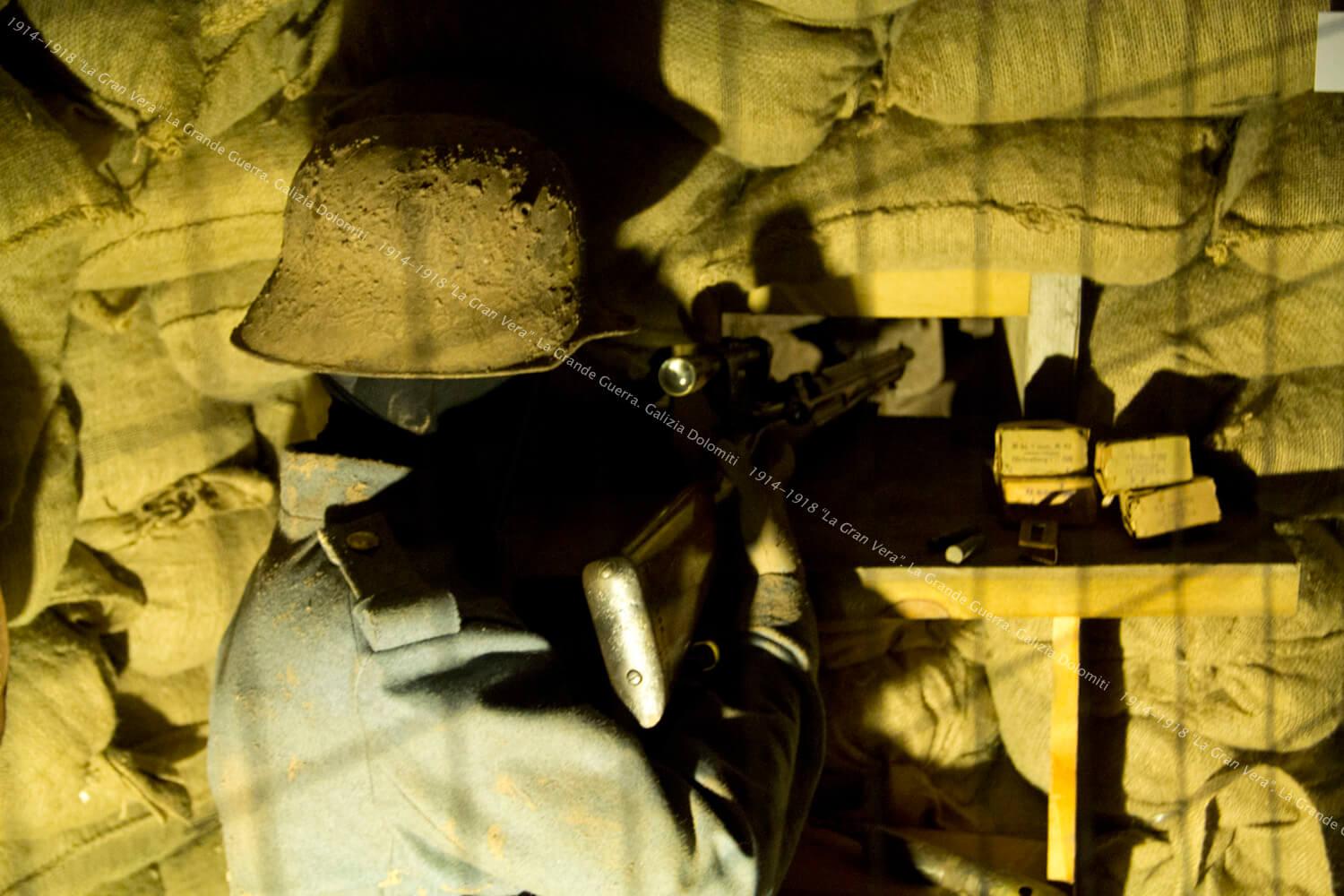
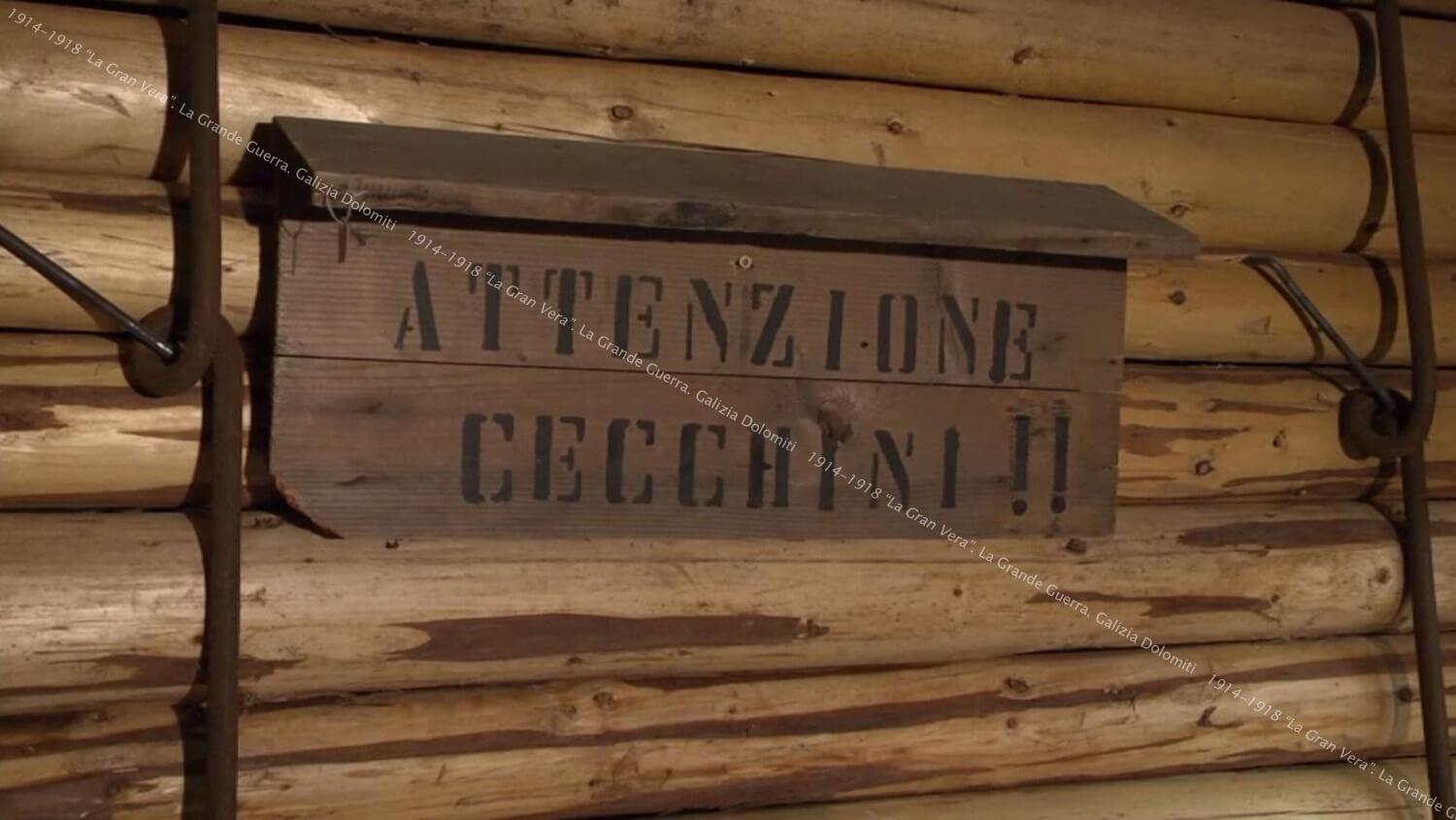
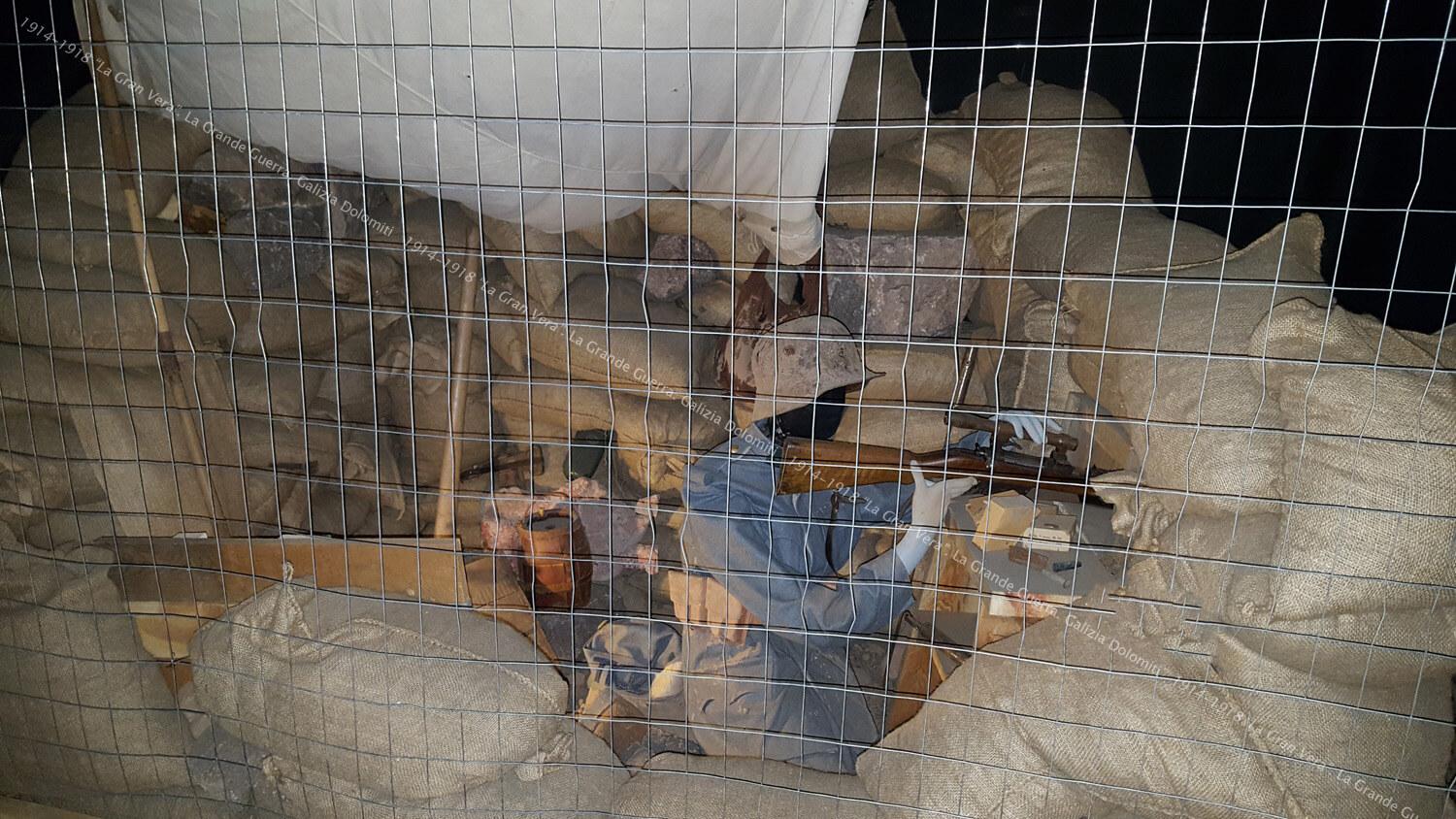
“And up on high, among the unburied dead, those buried alive: our holes filled with men, tiny vials of life in that nameless cemetery.”
Carlo Salsa,
Trenches, Milan 1929
---
“...to build the positions we grabbed whatever was available, including corpses of friends and enemies alike. We would place them on the parapets, to more easily stack the heavy rocks stuck in the terrain and to add protection, as they prevented the danger of shards...”
Abel Kornel, Karst - Ein Buch vom Isonzo,
Corticelli, Milan 1965
Small testimonies of soldiers’ everyday life: grappa and syrup bottles, mess tins and other everyday objects, writing implements, medals, forks, other utensils, as well as tools made with whatever was available, to make life in the trenches more dignified and comfortable.
Tins, haversacks, a helm drilled with a bayonet to turn it into a colander, a cup, flatware, plates and containers.
The personal supply of each soldier also included tinned meat, dried-bread biscuits, barley coffee and tobacco. It is interesting to note the differences between objects belonging to the two sides: Italians, for instance, only had spoons and used wooden flasks (later to be replaced by tin ones). Austrian-Hungarians also had forks (sometimes in their folding version, called Eßbesteck) and enamelled metal flasks with corks.
At the beginning of the war, in the Imperial army the everyday ration for each soldier amounted to 4,000 calories. After 1916, and especially in 1917, the supplied ration was no longer provided due to the famine caused by the war itself.
Early in the war, an Italian soldier, like those of pretty much all other armies, only had a packet of gauze for first-aid medication, and later also anti-gas mask and goggles. The transportation and the first aid provided to the wounded and the sick in the trenches was under the responsibility of the Military Medicine Corps, a service partly formed by Red Cross members and by military occasionally assigned under the directives of a medical captain.
The Alpine, bicycle Bersaglieri and Artillerymen had specific groups of health support in the high mountains, identified by a white band with a red cross around their arm. Each battalion had two corporals who could direct teams of eight stretch-bearers each for the transportation of the wounded to the advanced field infirmaries, the first true first-aid stations. According to the severity of their state, they could be triaged at the Medical Sections located in the sidelines, equipped with surgeons and cabins for x-rays and tests.
During the war, the most important medical supplies were aspirins and iodine, which could never be missing from infirmaries and hospitals. The lack of antibiotics and the poor sterilisation of instruments and medication materials resulted in high rates of infection of the wounds, and, as a consequence, many cases of gangrene.
Two musket rifles belonging to mountain troops; the shorter model was lighter and more functional in an attack. They were both equipped with loading plates kept in pouches attached to the belt, allowing the soldier to shoot five or six consecutive times. It was also possible to attach a bayonet to the rifle, a white arm that all soldiers received, for close combat in the trenches.
The tins were hung from the backpacks and soldiers carefully kept them clean with boiling water and ashes, or with sand and leaves, to keep food from drying, crusting and creating mould inside, which caused fastidious intestinal problems. Early in the war no army used metal helmets, but they were introduced a few months later to protect soldiers from shards and rocks launched in explosions. But they proved to be useless against rifles and large shards.
Reconstruction of an Italian command tent, with original uniforms and objects preserved in an excellent state. The chandelier, an extraordinary work of trench handicraft, for instance, was found in the San Pellegrino area. You can also see holsters, belts, snowshoes, puttees, crampons, leg sleeves, rifles, maps and a trench periscope.
Although stoves made a lot of smoke, they were crucial to keep tents warm. Tents were usually insulated with tarpaper. Here officers rested on improvised beds made of wood and covered in straw.
Soldiers used postcards and pictures to rebuild a familiar and cosy atmosphere as much as they could.
During WWI, the chemical industry was quickly developed, introducing lethal weapons that used asphyxiating gases and other toxic substances in the battlefield.
The effects on the soldiers were devastating, and yet not determinant for the outcome of the war.
Unprepared and devoid of protection equipment against these mortal substances, a primitive and ineffective improvisation used by soldiers was a cloth dampened with urine. The first anti-gas masks were developed later: they consisted of simple gags made of overlapping gauze layers or cotton buffers.
When they were to be used, the gauze was activated by damping it with chemical solutions. These masks were only effective against chlorine. Later on more sophisticated filters were added, as well as nose pinchers and anti-tear gas goggles with lenses made of acetyl cellulose.
The shelter, dated 1916, has been preserved thanks to the ice that has blocked its entrance. Used in summer as well as during the winter, it could house up to 12 men. It was dug into the rock and lined with wooden beams and posts. The shelter was equipped with a field oven that warmed it and was used to cook and to heat up food. This type of building was often equipped with electric power for lighting (thanks to diesel generators) and a phone line. It also offered protection against bombs and avalanches.
The Imperial and Royal Army (K.u.K. Heer) consisted of soldiers from all areas of the Austrian-Hungarian Empire, for a total of eleven different nationalities: Austrians and Hungarians, Bohemians, Polish and Slovaks, Ruthenians and Romanians, Italians, Croatians, Slovenians and Bosnians.
The Empire had nine official languages: German and Hungarian, Romanian and Ruthenian, Polish, Czech, Slovenian, Croatian and Italian. It acknowledged five religions: Roman Catholicism, Lutherans, Orthodox Christianity, Judaism and Islam.
In spite of the presence of various different languages, cultures and religions, the Imperial army was well organised: each regiment had its own regiment language, spoken by most of the recruits and by all officers. Documents and other official communication was written in German, a language known by everyone at least at an elementary level, as it was a compulsory subject in Austrian-Hungarian schools.
Recruits of the Imperial and Royal Army were usually included in the regiments stationed in their provinces of residence, although there were records of cases of recruits sent to the other side of the Empire.
The Austrian-Hungarian regiment of the Bosnians was very well-known and remembered for its fighting on the Dolomites front. Excellent soldiers, these were strong, calm, taciturn people always in the front line of the battle; men who “went to battle as they would go play cards” (G. Felicetti “Zompin”). Very loyal to the Emperor, who was Catholic, the Bosnians were Muslims, reason why they had some leeway when it came to the dressing code (they wore a fez) and their diet. Although their religion forbid alcohol, they found it hard to go to battle if not drunk. Their motto as they swarmed out of their trenches to attack the enemy was “nema ruma, nema sturma” (no rum, no attack).
The station was reconstructed using original parts: rocks, prefabricated cement shield and slot were recovered from the San Pellegrino Pass front.
The Schwarzlose consist of a tripod, the body of the weapon, a reservoir and a sleeve within which passed a water tube for cooling purposes; it has a belt loader with 250 shots. This is a department weapon with defence purposes and was used by soldiers trained to shoot series of gunshots. It also had light tripods so it could be used as assault weapon.
Machine guns of various models and types were adopted by all European armies between 1884 and 1887, and thanks to a system of semi-automatic repetition their shooting capacity reached 250/300 shots per minute, mowing down the battlefield and anything in front of it.
Italians owned very few machine guns, to the point they were forced to buy some from the allies.
Thanks to the work of thousands of soldiers and civilians made soldiers, who were paid for their work in the Ladin valleys, roads, paths and mule tracks were opened, cableways were built, stations and shelters were dug into rock walls, aqueducts, lighting and communication systems were built to allow mountain troops to survive at high altitudes.
Each soldier was given a spade, ice pick, hoe or pickaxe, essential to prepare a first shelter beneath enemy fire, with the menace of enemy counter-attacks.
Ice picks and hoes had two working sides that could be pointed or cut like an axe or a hoe; they had multiple uses, including removing reach, cutting branches and firewood, breaking ice, breaking the supports of nets if no other suitable tool was available, and, last but not least, as weapons. Iron spades were fundamental tools in the trench war. Italian spades were slightly different from the Austrian-Hungarian ones: they had longer handles, which made them more useful but less suitable for use as weapon in close combat. They can be recognised by the two holes in the blade, also used to fix it to the equipment, and for the notches cut into the handle, used to measure the depth of the digging.
Some examples of mesh poles examples can be seen here. The holes along the poles allowed for the quick fixing of the barbed wire.
The Skier Departments included skiing soldiers belonging to mountain troops. Their equipment included skiing equipment and specific garments that camouflaged soldiers in the snow.
This reconstruction shows an Alpine skiers with a light overcoat made of grey waterproof canvas, lined with grey-green fabric, and with a hood; mittens made of uncombed wool, ash wood skis with Huitfeld locks and bamboo rods with cane racquets.
Soldiers had a hard time surviving the hard climatic and environmental conditions. They were particularly exposed to atmospheric agents and bad weather. Dying by falling in the seracs was a common occurrence; a storm or fog on ice and snow could erase all traces of a path in a matter of minutes. The main danger up in the mountains, always lurking and more so in the winter, were avalanches, which could destroy absolutely everything - shelters, tents, cableways - and bury soldiers and materials, deposits and weapons.
It has been estimated that at least 10,000 men, both military and civilians, died in the winter of 1916/1917 due to avalanches.
Assault troops consisted of groups of specialised teams whose rapid action had the goal of creating a weakness among enemy defences, opening a gap so the infantry could advance. These specialised teams received light but very effective equipment, mostly grenades. Fighting with assault troops became one of the most effective fighting methods in the Alpine war. The success obtained by the patrol in fighting actions, which would have been considered less significant in other fronts, could yield relevant results in the mountain territory.
A rich collection of original battle equipment of the Italian and Austrian-Hungarian assault troops: fighting manuals, grenades and rifle bombs, bombs, assault helmets, an original uniform of the bold Italians, shields and armour, iron-lined clubs, original training manuals for the Sturmtruppe.
Grenades come in three categories:
- Defence grenades: made of a very heavy metal, their shards had an action range much wider than the throwing distance;
- Offensive grenades: made of light sheet metal and with a wooden handle, they were used during fighting, due to their rather limited action range;
- Rifle grenades: characterised by a metal rod that, when slid into the rifle, turned it into a small mortar.
Pistol, bayonet, dagger, iron-lined club, knuckleduster and Austrian spade.
In the Dolomites front, artillery played an important role: shortly after the beginning of the war, commanders realised that occupying mountain positions required taking weapons even to the highest peaks and glaciers.
Battles in WWI often began with days of bombing, with the purpose of removing obstacles, opening gaps in the barbed wire, demolishing machine gun stations and the enemy’s trench system. Attack itself only came later.
Cannons used in the mountains often used 75 and 65-mm bullets. In these operations, bombs, or trench mortars, were very important: always positioned in the front line, they were launched by traditional artillery (after 1916, by Bombardieri as well) and made it possible to throw powerful explosive loads over short distances. They were very dangerous, but incredibly important to destroy enemy trenches and netting: as they exploded, their shards could cut through barbed wire, unlike cannon bombs, which simply raised the netting without destroying it.
Many models of artillery bullets were used in WWI, differing according to their target. They could make holes and/or explode, there was shrapnel ammunition, machine gun bullets, gas, fire or smoke bombs, and according to need they were made of cast iron, steel cast iron or sheet metal, and could come with one or more forcing or centring bands.
They consisted of two parts:
- The case, made of light metal, mostly brass, is the lower part, containing the launching load. When it was shot, the case was emptied but remained in the explosion chamber of the cannon, so it could be reused;
- The projectile, which also contained gunpowder, is the part that is launched towards the target and that explodes upon impact by means of a fuse, or in the air, by means of a timed fuse.
Original artillery projectiles belonging to the Italian and Austrian-Hungarian armies, found in the front at San Pellegrino Pass.
In the centre, a Rollerbombe dated late 19th century. In WWI, this type of bomb was rolled down steep mountain sides and exploded using a timed fuse. This was a way to reuse material destined to now unused weapons.
This one, in particular, was found at Cima di Costabella, 2762 metres above sea level.
Normally used against infantry and in anti-aircraft operations, this is a grenade with very thin walls, containing numerous small lead balls that are violently projected all around it upon exploding. This happens thanks to a timed fuse, which causes the explosion of a small load of gunpowder placed in the rear of the projectile.
The war did more than just kill men. It damaged nature in an irreversible manner: both flora and fauna suffered irreparable damage. Woods and forests were massacred and destroyed by cannonballs; the great red spruces of our valleys are yet another symbol of the suffering endured by humankind during the Great War.
The no man’s land, the space between two enemy stations where armies dumped their waste, their dead, unexploded bombs, remains of weapons, and where the tangle of barbed wire mesh was articulated. It was the terrible strip of land that needed to be crossed during an attack, under enemy fire.
Reconstruction in Dolomite rock, with original objects.
Original rocks and objects collected from the battlefield. Reconstruction of a station of the 92nd Infantry Regiment of the Basilicata Brigade in line since April 1917, equipped with a CSRG machine rifle model 15 “Chauchat”, made in France.
Austrian sniper in position at Cima Bocche.
Reconstruction with original furnishings, including the Steyer M.95 rifle for mountain troops with optical viewfinder; notice the cardboard boxes containing ammunition.
The strong tradition of the snipers chosen from Tyrol was due to their hunting experience and the target practice of the Standschützen.
The word “cecchino” (Italian for “sniper”) was coined by Italian soldiers, very frequent victims of the ferocious shooting of the Austrians. It comes from Cecco Beppe, i.e. His Imperial Majesty Franz Joseph I of Austria.